#also most of Vietnam's history for her time period is like
Text

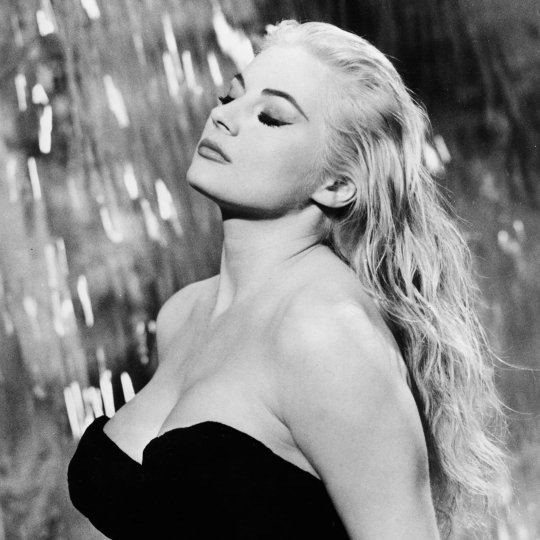
Propaganda
Xia Meng, also known as Hsia Moog or Miranda Yang (Sunrise, Bride Hunter)—For those who are familiar with Hong Kong's early cinema, Xia Meng is THE leading woman of an era, the earliest "silver-screen goddess", "The Great Beauty" and "Audrey Hepburn of the East". Xia Meng starred in 38 films in her 17-year career, and famously had rarely any flops, from her first film at the age of 18 to her last at the age of 35. She was a rare all-round actress in Mandarin-language films, acting, singing, and dancing with an enchanting ease in films of diverse genres, from contemporary drama to period operas. She was regarded as the "crown princess" among the "Three Princesses of the Great Wall", the iconic leading stars of the Great Wall Movie Enterprises, which was Hong Kong's leading left-wing studio in the 1950s-60s. At the time, Hong Kong cinema had only just taken off, but Xia Meng's influence had already spread out to China, Singapore, etc. Overseas Chinese-language magazines and newspapers often featured her on their covers. The famous HK wuxia novelist Jin Yong had such a huge crush on her that he made up a whole fake identity as a nobody-screenwriter to join the Great Wall studio just so he can write scripts for her. He famously said, "No one has really seen how beautiful Xi Shi (one of the renowned Four Beauties of ancient China) is, I think she should be just like Xia Meng to live up to her name." In 1980, she returned to the HK film industry by forming the Bluebird Movie Enterprises. As a producer with a heart for the community, she wanted to make a film on the Vietnam War and the many Vietnam War refugees migrating to Hong Kong. She approached director Ann Hui and produced the debut film Boat People (1982), a globally successful movie and landmark feature for Hong Kong New Wave, which won several awards including the best picture and best director in the second Hong Kong Film Award. Years later, Ann Hui looked back on her collaboration with Xia Meng, "I'm very grateful to her for allowing me to make what is probably the best film I've ever made in my life."
Anita Ekberg (War and Peace, La Dolce Vita)— I'm going to be frank with you. Every time I look at this woman, I lose my ability to form sentences.
This is round 4 of the tournament. All other polls in this bracket can be found here. Please reblog with further support of your beloved hot sexy vintage woman.
[additional propaganda submitted under the cut.]
Xia Meng:


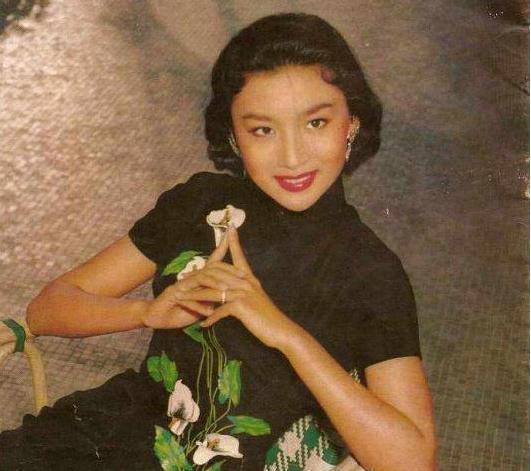


Anita Ekberg:
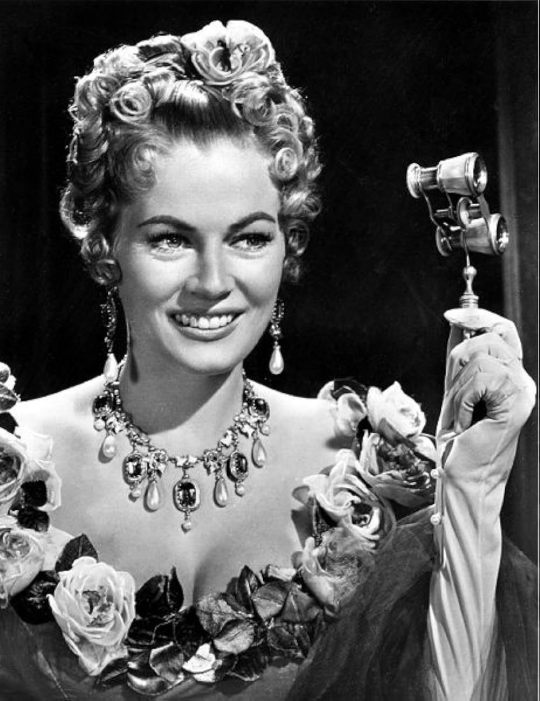
“I haven't seen much starring her (YET) but the scene of her in the Fontana di Trevi in La Dolce Vita is some of the most jealous I've ever been of Marcello Mastroianni maybe and that's saying a lot. Cinema history. Historical.”


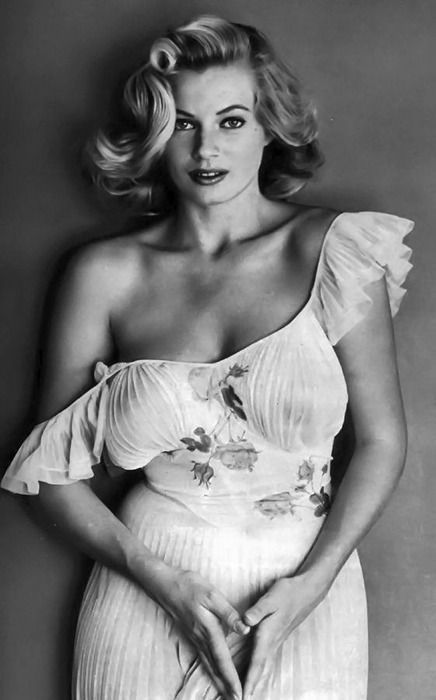
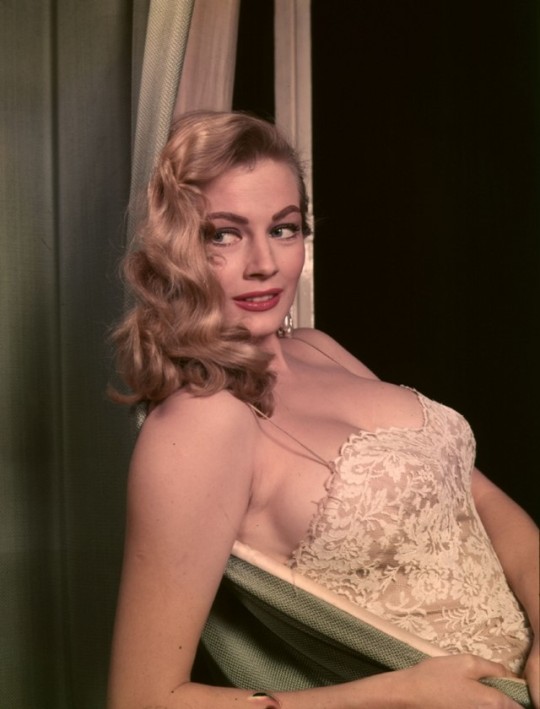
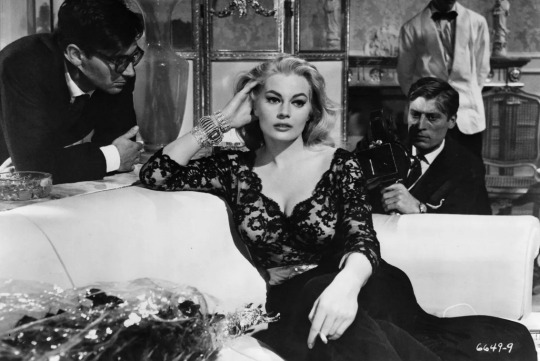
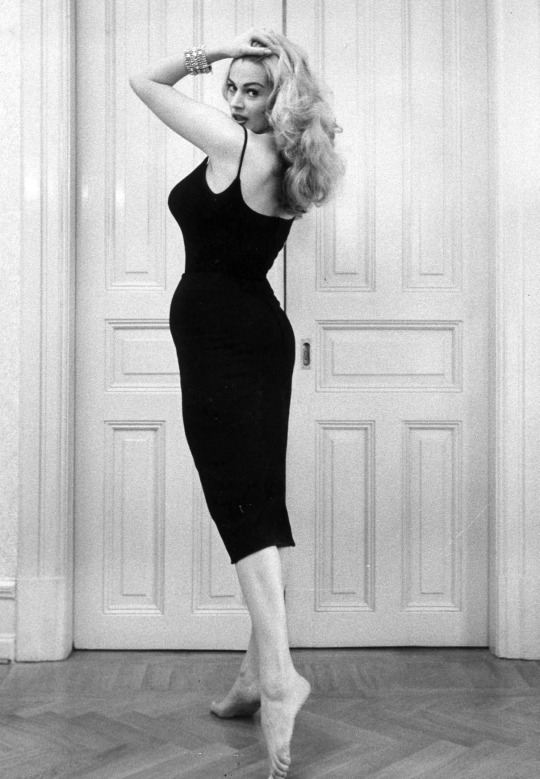
276 notes
·
View notes
Text
An intro to the historical Zheng Yi Sao
Ruibo Qian's character in Our Flag Means Death is based on a real person, though like all its real pirates, she is a loose interpretation. In particular, the real Zheng Yi Sao wasn't born until 57 years after the real Blackbeard died!
In real life, she lived from 1775 to 1844. She was known by a variety of names; her birth name is usually given as Shi Yang. Zheng Yi Sao is the name most often used, which literally means "the wife of Zheng Yi" (more on him later), and you may also see variations like Ching Shih or Madam Cheng, depending on transliteration. Calling her Zheng, as Oluwande does, is good, or ZYS in fandom chat, but if fic writers crave a more personal connotation for a scene, Yang is a good choice for a given name consistent with the real woman. It's like the difference between Mr. Buttons and Nathaniel.
She was born in the Guangdong province, and many bios of her claim she worked on one of the boat brothels there, but this is speculation only.
When she married Zheng Yi, he was a successful member of a pirating dynasty, working as a privateer for emperors of Vietnam. The couple collaborated to unite six different pirate fleets operating off the Guangdong coast into a confederation, sealed with an agreement signed by the captains of each. Zheng Yi was informally recognized as the overall leader of the confederation until his death in a storm two years after the signing.
Zheng Yi Sao had the respect of other key figures in the alliance, and her smooth assumption of leadership was followed by a period of huge success and expansion for the pirate confederation, driving the Chinese government to desperation. This is where her reputation as a pirate "queen" comes from in real life, though I'm excited to see where the show goes with her fictional conquest of China!
In 1810, Zheng Yi Sao recognized that the confederation faced internal fractures and additional opposition, as Portuguese and British military forces allied with Chinese ships, so she led the confederation to bow out on a high, and use their immense power to bargain for a peaceful retirement, surrendering ships and weapons for pardons, supplies, and money. Although it's fictional that her crew was predominantly women, when Zheng Yi Sao surrendered, she did so accompanied by a delegation wholly composed of women and children who belonged to the confederation. At that time, the confederation consisted of 226 ships, 24 of which personally reported to Zheng Yi Sao.
If you're doing the math, she was only in her mid-thirties, and was far from done with life. She remarried, to one of her former captains, Zhang Bao, and accompanied him to the Penghu Islands, where he commanded a garrison. After his death, she returned to Guangdong and had another career of twenty-odd years, becoming the owner of a casino until her death at age 68 or 69 (nice).
She was one of the most successful pirates in history, both because of her power and her ability to survive it. I think she's neat as hell, and so have a lot of fiction writers! You might have encountered versions of her, or characters inspired by her, before, in things like Pirates of the Caribbean, the Bloody Jack novels, Assassin's Creed, and Doctor Who. It's fun to see a form of her in this! We can expect her arc to progress differently, but I hope having some context will help.
The most helpful things to note for the rest of the season for ofmd fans will be that Zheng is her surname, she wasn't really a contemporary of the other historical figures, and that her connection to sex work should not be treated as a fact, whether you want to include it in this fictional interpretation or not.
265 notes
·
View notes
Note
What are the most insane bits of comics deep lore you can think of? I remember there was a post listing a highlight of some of the crazier bits, like how the Human Torch canonically killed Hitler, but it'd be nice if you made your own.
That was my post lol. But there are some more I can think of.
To solve the problem of characters with war-based origin stories becoming dated to real history and thus walking chronology headaches, Marvel introduced a completely fictional war — the Sin-Cong War — that replaces the role of most real world conflicts in the Marvel Universe. Mr. Fantastic and Thing’s originally stated history as WWII vets, Punisher’s past as a Vietnam veteran, Iron Man’s getting his chest injury and Juggernaut his magic gem in the Korean War, Professor X serving in the same war with his step-brother Juggernaut, and much more have been reworked as occurring in the Sin-Cong War, which is best described as “what Nam would’ve looked like in a world of superheroes”. The main exceptions are Captain America, Nick Fury, Namor, and Wolverine, all of whom have various excuses that allow them to keep their WWII service as canon.
Doctor Strange is immortal. It’s almost never brought up in adaptations, but in canon, the ritual he underwent to be officially named Sorcerer Supreme involved him being granted biological immortality by the Vishanti, meaning that he no longer ages. This has had the odd effect of making Strange yet another exception to the whole “comic book time” issue; he canonically became Sorcerer Supreme in the 70s and that has never changed at any point.
Black Widow is also functionally immortal, thanks to a special anti-aging serum she receives periodically (the same that Nick Fury uses), allowing her to still be written as somebody who was a Cold War spy, even as the comics progress into the 2000s onwards.
Black Panther once got called a race traitor by an African-American man for hanging out with white superheroes, much to his bafflement.
Spider-Man and Mysterio once walked into a theater in their secret identities at the same time, failed to recognize each other, and spent the entire time having a geeky conversation about their love of old movies.
When Grant Morrison wrote Magneto as being very evil in their X-Men run, other writers went tripping over themselves to retcon it away because of what I can only describe as a deeply parasocial relationship with a fictional supervillain. The original story involved Magneto disguising himself as a made-up new superhero named Xorn to infiltrate the X-Men and destroy New York. The retconned and now canon story involves Xorn’s evil twin brother pretending to be Magneto pretending to be Xorn doing that.
There’s a minor Spider-Man villain named Facade who was supposed to be the crux of an ongoing mystery plotline but poor reception led to Marvel scrapping those plans before Facade’s identity could be revealed. The result is that the comics now have a running gag of Facade showing up randomly every few years but never getting to reveal his name.
Man-Thing is not just a swamp monster that burns people when they’re scared, he is the guardian and manager of the Nexus of All Realities, a mystical location where the borders between realms is thin and dimensional teleportation is very easy. The Nexus is located in Florida.
Jubilee is canonically one of the most powerful X-Men, as while she mentally limits herself to small pops and fireworks to fight crime, she can actually generate massive and long-lasting explosions capable of devastating entire city blocks, something proven when she accidentally obliterated the Mandarin’s castle in a moment of panic. It has been speculated that she could make a new sun if she really put her heart into it.
Similarly, the most powerful member of the Fantastic Four is Invisible Woman, because her forcefield powers are so game-breaking strong that she can use them to blow up Celestials with a thought.
Conan the Barbarian, Count Dracula, Frankenstein, Godzilla, the Micronauts, and Rom the Spaceknight are all canonically real people in the Marvel Universe. G.I. Joe and the Transformers are also real in an alternate universe.
Doctor Doom once got extremely drunk while having a portrait of himself without his mask made and went on a very long rant about his mommy issues to the famous painter he commissioned for it. After learning what he did and also deciding that the painter’s brushwork left much to be desired, Doom disintegrated the man with a death-laser, which caused his paintings to receive a sudden spike in price value.
To give perspective on how hard it can sometimes be to keep a character permanently dead in Marvel nowadays… a writer once had Wolverine finally kill Sabretooth by maiming him beyond even healing factor repair and then decapitating him with a magic sword that was explicitly stated would purge Sabretooth’s soul if it so much as even touched him, and it was repeatedly and thoroughly stated and demonstrated that this was the real Sabretooth and not a clone or robot or anything like that, and a later writer supported this by showing Sabretooth’s soul in Hell. Less then a year later, Sabretooth was back and the new writer justified it with “Wolverine killed a clone”.
Similarly, when Marvel killed off their version of Dracula (see above), they included in that issue a supposedly legally binding document proving they couldn’t bring him back from the dead. He is now back from the dead.
Hercules has to regularly fight off accusations that his sidekick/best bud Amadeus Cho is his “eromenos” — that is to say, his submissive and breedable gay lover.
Moon Knight has recently purged New York of vampires by luring them all to a dinner party, using the fact that he’s technically the priest of the moon god Khonshu to consecrate all the water in the building into holy water, then activating the sprinkler system. There were no survivors.
Doctor Doom is not actually a doctor. He flunked out of college following the accident that scarred his face and the “doctorate” he now holds is one he unilaterally gave to himself after taking over Latveria.
Mr. Fantastic and Invisible Woman’s son Franklin is destined to become the next Galactus. If something goes wrong and he can’t do it, the role will be fulfilled by Mr. Immortal, a superhero with no power except coming back to life everytime he dies.
Scarlet Witch and Vision’s children, Wiccan and Speed, are technically not their children. They were born separately to different parents, but are the reincarnated souls of twin boys that Wanda once believed she had given birth to years ago but didn’t. Confused? You should be.
The planet Earth is sentient and sapient, being known as the Machine by the Eternals, who were created by the Celestials to maintain it. The Earth is a Trekkie.
Professor X is actually much younger than how adaptations tend to portray him, being only about in his mid-forties at oldest by this point in the comics. Magneto is significantly older then him, despite the tendency of people to assume they’re the same age.
Cyclops once stole a guy’s bike to save the world.
Deadpool is romantically involved with the personification of Death and thus regularly cucks Thanos.
#marvel#marvel comics#marvel universe#mu#the avengers#avengers#x men#xmen#iron man#spiderman#the amazing spider man#spider man#hulk#the hulk#the incredible hulk#cyclops#she hulk#black Panther#Deadpool#jubilee#magneto#professor x#doctor doom#Galactus#Great Lakes avengers#juggernaut
36 notes
·
View notes
Note
does Evelyn or any of your female characters ever struggle with their appearance? especially with the ever-changing beauty standards, "ideal weight", etc.
Ohhhh! That's such a good question! I never really thought about it before, but you are right! See I'm the loser who's like 'everyone is beautiful in their own way~' which I know can be distinctively unhelpful at times in the real world...
But it's interesting for nations, because I love discussions about if they are actually beautiful, or if some genuinely are butt ugly (but in what way if you catch my drift, because then it risks crossing over into tying moral purity with beauty, which is such a lazy trope and a dangerous one too I think). There will also be instances of those with chronic illnesses or injuries which will affect their opinion of themselves, and society's view of them too. I think gender again comes in here. Especially in nations, where female nations are rarer. Gender and beauty standards are sort of inextricably entangled.
I think most nations are, at the very least, interesting to look at. If such a thing is possible without leering like a creep. Plus, as you say, with the changing attitudes to beauty, someone like a female England would be considered somewhat unattractive for most of her history, except for certain periods like the late Victorian/early Edwardian, the 20s (minus the bob), the 60s (mod fashion) and 90s (the horridly names heroin chic comes to mind).
It's tricky though, right? Are they so old that human standards no longer affect them? Or are they so painfully human in this regard where the need to be physically attractive is still something they want? To be wanted? Or is that too vulnerable? Maybe it's more pragmatic, that to be considered beautiful allows them to buy into Beauty = Goodness and therefore give them some kind of leverage since, as female nations, they will lack political power that most of their male counterparts have without a second thought etc etc...
The trap of a misogynistic and patriarchal system is you either play by the rules (and get punished for it), or you reject the rules and go your own path... and get punished for it. So the girls cannot win. I can imagine they all, after so long start to develop really twisted views of their own bodies.
To run through each girl, New Zealand's is twisted up in colonial white understandings of beauty which is juxtaposed with the Māori, so then how do you marry those two up? Should she? Then in South East Asia I can imagine Vietnam worked super hard at this. To train herself out of worrying about the tone of her skin, and how her hair should behave, or if she has too many muscles and isn't 'soft' enough. She will rock up in a t-shirt and shorts, and that's enough. She's more than enough. Moving further north, Taiwan elects to go with being cute over being beautiful because those are parameters that she can control. Cute could be considered a female driven standard. I may be mis-remembering, but there's several trends in East Asian fashion (the Japanese Lolita comes to mind) which are born around being as visually unappealing to men, but as visually appealing to women as possible. I think Taiwan may take that approach.
Zipping over to Europe...
The fact the Belgium is literally described as being plain by Hima (which... okay) means to me she that, if she doesn't stand out against a crowd, she learned how to be the centre of attention through her personality and charm. She dresses practically and plainly maybe because she is not interested in being the centre of attention. She believes her personality and her relations will carry her through. Czechia slams right into tomboyishness, perhaps thinking of how she is surrounded by boys, ergo, she has to be one of the boys to get through it. And maybe she's totally fine with that? Maybe her gender and perception of self is really fluid and she is whatever she fancies being at that moment. But not to the point where being called cute by Slovakia doesn't completely throws her for a loop still. Though that may be just from never being on the receiving end of a compliment rather than it jarring with her presentation and perception of self... could be both?
And of course Hungary has her own gender and self perception journey and I can imagine she had a wild time of it when the realisation of what was going on actually hit. I don't know what I think a cis character realising they're cis and being totally fine about it at the end of the day would look like but... well that's Hungary. She seems very content with herself. I like to think it was not just a simple conversation and all is well. I like to think there was a lot of conversations and thinking and testing the waters until she got where she is today.
For a long time, the European standard was high forehead, long neck, small shoulders, small waist but noticeable stomach and hips. Pear shaped? Them birthing hips. Then, in addition, the 'usual' for Western Northern Europe (which is still in effect in many places) is blonde hair, blue eyes, and pale skin. Red hair is bad, freckles are bad. All the Atlantic Archipelago nations have freckles. But I think maybe say Ireland gets the body shape but England gets the colouration (until she starts to turn grey - English Roses require pink noses cheeks and ears and she's half blue at points so...) but neither sister checks each box in turn.
Evelyn has always been small - short and skinny even in her "good" years, but she, for most of the fic, is positively skeletal. Sunken big eyes, small mouth, and a sharp nose and ears. I had a comment telling me I missed the bird comparisons (Eva Avis) but yeah, she's a small robin bird. Territorial to boot. Like, Arthur has increasingly over the years been depicted as incredibly fey and scrawny. I was lazy and did the same with the female!
In the fic, Evelyn is desperate to be wanted. If she can't be a romantic partner for someone, if she can't be desired in that way, she'll take the other route, that of motherhood, which is a role that doesn't take your worth from your appearance. I didn't really talk about how she views herself - if she thinks she is pretty or beautiful or if she's ugly or if it never really crosses her mind at all - but I think maybe it's her lack of health that is what eats at her. So she sticks to what she knows. She wears beautiful dresses when she needs to because she likes beautiful things, but also restricts in what materials she goes for to prove a point to no-one except herself. Otherwise loose and comfy is what she goes for. She doesn't like people touching her hair, and she never cuts it for reasons that I have not yet decided on. She likes to wear pearls because they're a metaphor for empire in the fic and the fact that to have a pearl is to murder the creature that gave you such beauty and the reason she never wears them around Ludwig is because she can't hold leverage over him no wait
Anyway. I think maybe most nations, as time passes, as they grow slowly, as they retain wounds and scars from damage to their land and bodies... health is what becomes the most important. For most of history, flushed cheeks and ears, bright eyes, shining hair and clean teeth are signs of beauty. Health, I think matters most. Which is why when nations are struggling, especially the female ones, it can get quite difficult for them. As I said at the start, it is an easy but lazy trope to tie health with value and beauty, especially in the centuries where a person's value was determined by their usefulness, but that doesn't stop people for believing it over the millennia. You have to take a cleaver to it, separate them into distinct spheres.
#It's just all a honk of confusion isn't it? beauty and health and gender and self worth#hetalia#q&a#fanfic ask#i hope this makes sense I think I worded some of this poorly
3 notes
·
View notes
Text

Russell Senior and Ralph Parmar - the Two Tribes production team.
The production is based on the lives of two 18 or 19 year-old lads, one from a small pit village in Yorkshire and one from a small pit village in Nottinghamshire.
The two lads are friends, possibly more, but their relationship is hugely affected by the strike. The production spans a spectrum of qualities, from comedy to tragedy, and remains focused on the social context throughout.
“It also touches on the North/South divide,” says Senior. “Apparently the actual ‘divide’ between the north and south is in north Nottinghamshire and this divide relates to a Roman fortification. The line divides the rebellious Celtic north with the Romans.”
Sheffield Telegraph
[The link is to an archived webpage and is likely to disappear at some point when the archives need a clean.]
A striking musical
Published on Monday 20 February 2012
The Miners’ Strike in 1984-5, one of most divisive moments of British 20th-century political history, is being brought to the stage for a musical production by a Pulp star and one of Sheffield’s best-known DJs.
Little remains of the coal mines in South Yorkshire that triggered those landmark events of the 1980s when the unions confronted the Thatcher government, only the desolate remnants of former mining villages.
But for the people whose families were affected by the famous strikes, this history is very easily recalled. One such person is Pulp’s Russell Senior who, along with Sheffield-based DJ Ralph Parmar – better known as Ralph Razor – has written a musical production based on the miners’ strike.
The pair started penning the script for the play in April 2010 but the production process was somewhat inhibited by Senior’s massive reunion tour with Pulp. “When we went on tour with Pulp the production was put on hold – I had to learn about 140 songs in a matter of days.”
Senior is the son of a Sheffield steelworker who lost his job in the 1980s, so watching Thatcher turn her attention to the miners felt very close to home.
His memories have been mined for the production’s material. “I was 18 when the strike was happening and I have drawn from that experience in the production.
“It was horrendous – Britain’s Vietnam War. It was awful seeing people you know all around you being made unemployed by the decisions of a Tory government.”
Senior said: “Thatcher was deliberately provocative in the way she orchestrated it all. There was malice in the whole thing, she was building up coal stocks in anticipation of this and she turned the police into a paramilitary force. It was like Pinochet’s Chile. The ratio of men on the picket being hurt to police injuries was 20 to one.”
Senior and Parmar’s production company – Two Tribes – takes its name not only from the schism that divided Britain but also the chart-topping Frankie Goes to Hollywood track, which was about the Cold War, of the same year.
Ralph has spent time researching pop tracks from the period that were played on the radio and throughout South Yorkshire’s clubs – songs that were relevant to the mining community at that time.
The pair have also spent a considerable amount of time massing a wardrobe to rival any retro broadcast of a 1984 Top of the Pops programme, with racks and racks of bat-winged jumpers, jackets with Power Ranger shoulder pads and hideously unflattering skirts. In terms of historical detail, little has been overlooked.
But while Senior’s seniority has given Two Tribes historical clout, the idea to produce a musical about the strike was Parmar’s idea, as he explains. “I emailed Russell and said ‘I’ve got this idea’.” Senior interjects. “I wrote back and said ‘that is a ridiculous idea and I don’t want to be involved.’ But then I thought ‘actually, the idea is so preposterous that I do actually want to be involved.”
The production is based on the lives of two 18 or 19 year-old lads, one from a small pit village in Yorkshire and one from a small pit village in Nottinghamshire.
The two lads are friends, possibly more, but their relationship is hugely affected by the strike. The production spans a spectrum of qualities, from comedy to tragedy, and remains focused on the social context throughout.
“It also touches on the North/South divide,” says Senior. “Apparently the actual ‘divide’ between the north and south is in north Nottinghamshire and this divide relates to a Roman fortification. The line divides the rebellious Celtic north with the Romans.”
And while Two Tribes is a musical, Parmar is keen to make it subtle. “It’s not going to be like My Fair Lady where people break into song randomly, we bring songs into it in a plausible way and when it would naturally happen – like singing in the pit head showers.”
Two Tribes will be debuted this year and Senior and Parmar have plans to take it across the country. Its premier, however, will be here in Sheffield, on its historical home turf.
The pair are already holding auditions for parts and are looking for actors and actresses to star in the show.
For details, visit www.tt84.co.uk A snippet of the production will be performed at Tramlines this year.
2 notes
·
View notes
Text
Body modification, Media and Cultural Preservation
Body modification is one of the oldest concepts accompanying human culture. According to Britannica, since prehistoric times, discoveries about body modification tools of ancient people have existed in many cultures. chemistry. This demonstrates beauty initiatives and needs, which according to Idea Ted, "Gates also notes that people act differently in beautiful environments, suggesting that beauty can foster care and pride in one's surroundings." Or as Helicon personally stated in the discussion "Some argue that beauty is not just instrumental for economic or social outcomes but is a fundamental human need in itself, with a role in fostering justice and peace."
This is obvious because human beauty needs are one of the basic and essential needs. Another factor as mentioned in previous articles, the 21st century witnessed the explosion of social networks with individual and small content creators appearing more and being shared more. This once again leads to a higher demand for personal beauty as anyone can now appear in public. (This links to the concept that the first impression is always the most important - according to 9soul.vn)
However, there is a contradiction here: if body modification is a more potential market than ever throughout history, then why is it in conflict with preserving traditional culture?
Take a representative example of modern media cases, which is the image of Ba Tung. Ms. Tung, real name Le Thi Huyen Anh, is a famous figure on social networks in Vietnam. She is known for her shocking images and statements, as well as expressing herself through videos and posts on online platforms. Below is some information about Ba Tung:
Fame: Ms. Tung has attracted attention through sharing personal and controversial content on social media. Like photos that reveal women's sensitive areas
Recent Activities: Recently, she appeared in a male singer's MV with a sexy and attractive image.
Although there is a train of thought when taking this example as it is more about using media content and not body modification. However, remember that any visual device and posting on social platforms with a perfect appearance is edited. (we will compare photos of Ba Tung below).
This makes Ba Tung a controversial example of being too sexy, going against Vietnamese customs and traditions.
This creates two streams of judgment.
First, why are there so many creators today who reveal more personality and sexiness from their bodies without being criticized, but Ba Tung is criticized for going against tradition so much? An understandable explanation is that she is a pioneer in this matter, so if the public is not familiar with it, it is natural to face criticism.
Next is why there is such criticism. An explanation according to The Rangeview Raider Review The need for beauty is a constant because it is deeply rooted in human nature, often associated with harmony, balance, and a sense of well-being. However, the perception of what is considered beautiful can vary across diverse cultures and time periods.
The conflict between contemporary beauty standards and traditional culture arises from several factors:
- **Cultural Evolution: ** As societies evolve, so do their cultural norms, including those related to beauty. What was once considered beautiful may change or expand to include new standards⁵.
- **Globalization: ** The spread of Western ideals of beauty through media and pop culture has influenced beauty standards worldwide, sometimes clashing with local, traditional aesthetics.
- **Media Influence: ** Media often promotes a narrow range of beauty standards that may not align with the diverse expressions of beauty found in traditional cultures.
- **Body Image and Identity: ** The portrayal of beauty in the media can impact individuals' body image and self-identity, leading to a conflict between embracing one's cultural heritage and conforming to modern beauty ideals.
- **Commercialization: ** The beauty industry's focus on certain standards can marginalize traditional beauty practices, leading to a cultural shift that prioritizes commercialized beauty norms.
The need for beauty persists because it fulfills a fundamental human desire for aesthetics and self-expression. Yet, the definition of beauty is ever-changing, influenced by a complex interplay of cultural, economic, and social dynamics.
Works Cited
A, Orellana, Michelle. “The Constant Conflict between Female Beauty Standards and Society.” Veritas News, 28 Feb. 2016, veritas.enc.edu/2016/02/28/constant-conflict-female-beauty-standards-society/.
Aiken. “Vì Sao Ấn Tượng Đầu Tiên Lại Quan Trọng?” Tâm Lý Học Ứng Dụng, 24 Mar. 2017, tamly.blog/vi-sao-an-tuong-dau-tien-lai-quan-trong/. Accessed 3 Mar. 2024.
“Beauty Standards and Cultural Influences - Women’s Journal.” Womensjournal.com, 23 Feb. 2024, womensjournal.com/beauty-standards-and-cultural-influences/.
“Is Beauty a Basic Need and Right? | Helicon.” Heliconcollab.net, heliconcollab.net/beauty/. Accessed 3 Mar. 2024.
Johnson, Mandy. “How Culture Influences Beauty Standards * Arts Equity LA 2022.” Arts Equity LA, 18 May 2022, artsequityla.com/beauty-ideal/culture-influences-beauty/.
LINDA, SARAH-. “Why Beauty Is Essential to Your Happiness.” Sarah-Linda, 11 Dec. 2020, www.sarahlindaforrer.com/journal/2020/12/11/why-beauty-is-essential-to-your-happiness. Accessed 3 Mar. 2024.
Scheel, Judy. “Culture Dictates the Standard of Beauty.” Psychology Today, 2014, www.psychologytoday.com/us/blog/when-food-is-family/201404/culture-dictates-the-standard-beauty.
Tsehaye, Bezael. “Beauty Standards throughout Culture.” The Rangeview Raider Review, rangeviewnews.org/25683/features/beauty-standards-throughout-culture/.
---. “Beauty Standards throughout Culture.” The Rangeview Raider Review, rangeviewnews.org/25683/features/beauty-standards-throughout-culture/.
“Why Beauty Matters.” Ideas.ted.com, 14 July 2015, ideas.ted.com/why-beauty-matters/.
0 notes
Text
“The Old Guard” Daemon AU: Quynh and the king cobra
Since we don’t separate couples in this house, after Andy here comes Quynh. She’s just as badass as her axe-wielding wife, so she has a similarly Iconique daemon
the king cobra is the longest venomous snake in the world; adults range between 3,75 and 5 m, and weigh up to 10 kg, and males are bigger than females. Quynh is terrifying (affectionate), so her having a Big Murder Noodle as daemon is on par with her

king cobras are apex predators, snakes that eat other snakes; their only natural predators are humans. Quynh, like Andy, is a force of nature, so she deserves to stay on top of the food chain

like most venomous snakes, king cobras kill their prey by biting them, injecting a high dose of venom, and then eat it. Quynh, that Joe described as a pit viper in a fight, seems to be a “one strike and you’re dead” type of warrior, especially being an archer
on that same note, a group of king cobras is called a quiver, and a quiver is also the pouch where archers keep their arrows. So. Sounds like destiny
king cobras are diurnal, so they possess a good eyesight, together with a strong sense of smell; they also spend a lot of time on tree branches, from which they lean down to hunt – sniper Quynh my beloved

while they usually prefer avoidance to confrontation, king cobras tend to take an aggressive stance when disturbed – raising up to the chest, opening the hood, and hissing. Since they’re also much larger than many snakes, they can also attack from a certain distance if bothered. I think Quynh has the spirit of an observant (she was the sniper before Nicky and I will die on this hill), and she doesn’t start fights if she doesn’t need to; but she won’t take any bullshit from anyone, and those that test her don’t live long enough to regret it
king cobras are long-lived snakes (20 years on average) and although they’re solitary during the year, they tend to stay with the same partner for the mating season, and it’s the only snake species that actively builds a nest for its eggs, which the female guards ferociously. 🎶 ~ Found Family Vibes Babe ~ 🎶
a king cobra’s scales are usually a mix of green, brown, black and yellow, with the yellow scales forming very slight stripes on the top portion of the body. It’s not the flashiest coloring among snakes, but it’s surely elegant, and Quynh is obviously a fashion icon, and her daemon’s coloring goes with all her outfits – what do they say, black goes with everything?

The habitat of the king cobra spans from southern India to most of Southeast Asia, from lowlands up to an elevation of 2000 m. They live in forests, swamps, bamboo thickets, grasslands, and rivers – they are good swimmers. Coincidentally, Vietnam has declared the king cobra a protected species (go Vietnam!); so it’s an animal that Quynh would have been familiar with

according to the Netflix featurette video, Andy found Quynh around 1000 BCE – take away the century that it took her to actually find Quynh, and assuming that Andy started looking for her as soon as the dreams started (which I think she would have, desperate for company as she was), we could place Quynh’s death around 1100 BCE – give or take the thirty/forty years Quynh actually lived
I am assuming that Quynh lived in the Red River delta area in northern Vietnam; this date would place her at the tail end of the Dong Dau archaeological period of the Hong Bang dynasty (the predecessor of the Dong Son culture), and she would have been a Lac Viet
the Lac Viet were an agricultural society with a sort of feudal system, where inheritance was passed through both the paternal and maternal line; also, when someone got married, they became a member of the wife’s family instead of the husband’s
in most Asian cultures snakes have a neutral or positive depiction, from symbols of rebirth (due to their periodical shedding of the skin) and immortality (think of the ourobouros), to fertility (humans will see an elongated anything with a differentiated head and go ‘is this a phallic reference?’) to guardians of temples or divine figures (especially cobras, for their defensive positions); the Vietnamese dragon itself is a combination of various animals, including the snake
one of the legends about the origin of the Vietnamese people is that of Lac Long Quan, legendary founder of the Hung dynasty, whose mother was a dragon goddess, and Au Co, an immortal fairy of the mountains who could turn into a bird. She bore him 100 children, and when they separated (he to the seas, she to the mountains) the children also split between their parents
in Vietnam’s folk religion, the snake, as an amphibious animal, is meant to possess the linh, the “spirit”, a power of mediation between âm (yin, the disorder) and duong (yang, the order). It lives on the threshold of water and land, and thus is associated with divine figures with luminal powers between order and disorder, especially goddesses
the neighbouring Cambodians also believe to be descended from nagas, the snake gods also present in Hindu and Buddhist mythology
this would mean that Quynh having a snake daemon, in her original culture, would have been considered positively, even reverently – and in her travels through Asia, said snake being a cobra probably was looked at even more benevolently
(imagine how pissed off she must have been that the onset of Christianity would make people recoil away from her and her daemon)
After. A painful search. I have settled for Thang for the daemon’s name. It means “victory” (or “victorious”, depending on the sources), and it feels like a good thing to name a person’s daemon, especially if we assume that Quynh had a warrior training in her first life too
(there is One (1) Thing I know of him. He has a Deep Sexy Voice, like. Imagine James Earl Jones. That’s how I can imagine him speaking. A soothing deep bass that makes you feel instantly at ease – haters will say it’s manipulative. Quynh regularly goes “if Thang was a tiger you wouldn’t say that, you cowards”)
Fun fact: in almost all legends and mythologies snakes and eagles (or snake-like and eagle-like entities) are mortal enemies since, you know, snakes represent the chthonic world and eagles represent the skies. And yet Andy and Quynh looked at each other and went ‘fuck it, that’s my wife now’ and that’s Very Sexy of them
(I can see Diokles sleeping on the closest tree branch above Andy and Quynh with Thang gently coiled around him so he can also Keep Warm)
References outside of Wikipedia and directly linked sites:
Đõ̂, Thiện (2003): Vietnamese Supernaturalism: Views from the Southern Region. Psychology Press, 300 pages
Dutton G.E., Werner S.J., Whitmore J.K. (2012): Sources of Vietnamese Traditions. Columbia University Press, 622 pages;
McLeod M.W., Nguyen T.D. (2001): Culture and Customs of Vietnam. Greenwood Press, 198 pages;
National Geographic’s Photo Ark – King Cobra;
Taylor, K.W. (1983): The Birth of Vietnam. University of California Press, 397 pages;
Taylor, K.W. (2013): A History of the Vietnamese. Cambridge University Press, 696 pages.
#the old guard#my ponderings#daemon AU#quynh#nature#animals#king cobra#the fact that I don't have a Quynh descriptive tag is a shame hope the sequel fixes that#THIS WAS. A PAIN.#and it's also considerably shorter than the other four I'm sorry#problem is - if we go back to canon we have SO LITTLE MATERIAL on Quynh to work on#most of my characterization for her is Unexplainable Vibes#and there's also very little info on king cobras I found out#for all the other animals I found monographies but for the cobra? Not a thing#also most of Vietnam's history for her time period is like#'yeah Chinese historians in the 14th century talked about this society and their mythological kingdoms and that's all we know'#so even though I listed multiple resources they're all repeating the same three things about pre-Han invasion northern Vietnam sorry#I didn't put any diacritic accents on names hope it's not too much of a problem#king cobras have this thing that they look fucking menacing but on certain angles they have such a Dumb Noodle Face lol
63 notes
·
View notes
Text
St Vincent: “Pour a Drink, Smoke a Joint... That’s the Vibe”
Ding dong! Daddy's Home
By Johnny Davis
19/03/2021

Annie Clark, known professionally as St Vincent, picked up a guitar aged 12 after being inspired by Jimi Hendrix. During her teens she worked as a roadie and later tour manager for her aunt and uncle, the jazz duo Tuck & Patti. Originally from Oklahoma, she moved to Dallas, Texas when she was seven and later attended the Berklee College of Music in Boston, Massachusetts for three years, before dropping out.
Clark worked as a touring musician with the Polyphonic Spree and Sufjan Stevens, before releasing Marry Me, her first album as St Vincent, in 2007. By her fifth album, 2017’s Masseduction, she had become one of the most celebrated artists in music, the first solo female artist to win a Grammy Award for Best Alternative Album in 20 years.
She became unlikely Daily Mail-fodder around the same time, thanks to an 18-month relationship with Cara Delevingne, and later Kristen Stewart. Her ever-changing music, dressing up-box image and head-spinning well of ideas have seen her compared to David Bowie, Kate Bush and Prince. To complete the notion of her being the "artist's artist", in 2012 she collaborated with David Byrne on the album Love This Giant.
Indeed, she is surely one of few performers today who could stand in for Kurt Cobain with what’s-left-of-Nirvana, performing “Lithium” at their induction into the Rock & Roll Hall of Fame in 2014, as well as cover “Controversy” at a Prince tribute concert in 2020, with such guitar-playing fireworks its author would surely have approved.
Following the glam-influenced pop of Masseduction, St Vincent has performed another stylistic handbrake turn. Complete with a new image – part-Warhol Superstar, part-Cassavetes heroine – she has mined the textures of the music she loved most as a kid: the virtuoso rock of Steely Dan, the clipped funk of Stevie Wonder and blue-eyed soul of mid-Seventies' David Bowie, on her upcoming album, Daddy’s Home.
The title refers to Clark's own father, locked up in Texas for 12 years in 2010, for money laundering in a stock manipulation scheme, one in which he and his co-conspirators cheated 17,000 investors out of £35m. It is also, in typical Clark style, a bit of saucy slang.
Back on the promotional trail, Clark Zoomed in from Los Angeles one morning recently – fully caffeinated and raring to go. “My vices?” she pondered. “Too much coffee, man…”
What question are you already bored of being asked?
There’s not one that’s popping out. There’s no question where I’m like “Oh God, if I ever hear that again, I’ll jump off a building.” I’m chill.
I mention it because prior to releasing your last record you put out a pre-recorded “press conference”, seemingly to pre-empt every inane question the media would throw at you.
It’s so funny. It didn’t really occur like that. Originally that was supposed to be a legit green screen conference. Like, “I’ll just answer these questions ‘cos when they need to have me on ‘The Morning Show’ in Belarus they can have this and put their own graphics behind it”. But then when my friend Carrie Brownstein [collaborator and Sleater-Kinney vocalist-guitarist] and I started writing it and it became very snarky. For some reason it didn’t occur to me that “Oh, that might be off-putting or intimidating to journalists” I just thought "This is silly”. So anyway… I understand.
We're curious about your dad and the American legal system.
I have had a lot of questions about that. For some reason it didn’t occur to me how much I would be answering questions about… my hilarious father!
How do you view his time in prison?
Just that life is long and people are complicated. And that, luckily, there’s a chance for redemption or reconciliation, even after a really crazy traumatic time. And also anybody that has any experience with the American justice system will know this... nobody comes out unscathed.
You recently presented an online MasterClass: "St. Vincent Teaches Creativity & Songwriting". One of the takeaways: “All you need are ears and ideas, and you can make anything happen”. Who’s had the best ideas in music?
Well, you’ve got to give credit to people who were genuinely creating a new style – like if you think of Charlie Parker, arguably he created a new style. This hard bop that was just absolutely impossible to play. It was, like, “Check me out – try to copy me!” So, that’s interesting. I think Brian Eno, for sure, has some great ideas about music – and obviously has made some of the best music. Joni Mitchell – completely singular. I mean: think about that. There are some people who are actually inimitable – like, you couldn’t possibly even try to imitate them.
It’s a brave soul who covers a Joni Mitchell song. Although, apologies if you actually have.
No, I have not. And there’s a reason why not. Come on – Bowie. Bowie never repeated himself. David Byrne also didn’t repeat himself. He took all of his influences of classic songs and the disco that was happening at the time, and the potpourri of downtown New York music from the mid- to late Seventies… and synthesised it into this completely new, other thing. I mean, that’s impressive. Those are the ones we remember.
How hard is it not to repeat yourself?
It’s whether people have the Narcissus thing or not. Like, it’s always got to be a balance where you’re, like, “Well, I need to believe in myself to make something and be liberated. But I can’t look at that pond of my previous work and go ‘Oh you! You’re gorgeous!’” So I don’t go back and listen to things I’ve done. I finished Daddy’s Home in the fall and it was, like, “This is done” and it felt great. I loved the record and it was so fun to make. But what I did immediately afterwards was to write something completely different. But then I don’t know, ‘cos there are people who do the thing that they do just great. And you just want to hear more songs, in the style of the thing that they do great.
Right. No one wants an experimental Ramones album.
Exactly. Or, like, or a Tom Petty record. I don’t want a tone poem from Tom Petty! I want a perfectly constructed, perfectly written completely singalongable three-chord song.
The new album has a very “live” Seventies feel. I’d read that some of the tracks are first takes. Can that be right? It all sounds very complicated.
That’s not right. I should say [rock voice] "Yeah, that’s right, we just jammed…" But, you know, I’ll be honest. There are some vocal takes in there that are first takes. But it really is just the sound of people playing. We get good drum takes. And good bass takes. And I play a bunch of guitar and sitar-guitar. And it’s the sound of a moment in time, certainly. And way more about looseness and groove and feel and vibe than anything else [I’ve done before].
Amazing live albums, virtuoso playing, jamming – those were staples of Seventies music. Have we lost some of that?
I mean, I can wax poetic on that idea for a minute. In the Seventies you had this tremendous sophistication in popular music. Stevie Wonder, Steely Dan and funk and soul and jazz and rock…. and all of the things rolled into one. That was tremendously sophisticated. It just was. There was harmony, there were chord progressions.

What else from that decade appealed to you for Daddy’s Home?
It reminds me of where we are now, I think. So, 1971-1976 in downtown New York, you’ve got the Summer of Love thing and flower children and all the hippy stuff and it’s, like, “Oh yeah, that didn’t work out that well. We’re still in Vietnam. There’s a crazy economic crisis, all kinds of social unrest”. People stood in the proverbial burned-out building. And it reminds me a lot of where we are today, in terms of social unrest, economic uncertainty. A groundswell wanting change... but where that’s headed is yet to be seen. We haven’t fully figured that out. We’re all picking up pieces of the rubble and going “Okay, what do we do with this one? Where do we go with that one?” Being a student of history, that was one of the reasons why I was drawn to that period in history.
Also: that’s the music I’ve listened to more than anything in my entire life. I mean, I was probably the youngest Steely Dan fan. It didn’t make me that popular at sleepovers. People were, like, “I want to listen to C+C Music Factory” and I was, like, “Yeah, but have you heard this solo on [Steely Dan’s] ‘Kid Charlemagne’”? That music is so in me. It’s so in my ears and I feel like I never really went there [making music before]. And I didn’t want to be a tourist about it. It’s just that particular style had a whole lot to teach me. So I wanted to just dig in and find out. Just play with it.
Is there a style of music you don’t like?
That I don’t like?
You're a jazz fan...
I love jazz. Are you kidding me? I was that annoying 14-year-old who was, like, “Yeah, but have you listened to Oliver Nelson’s The Blues and the Abstract Truth?”
I love jazz. Are you kidding me? I was that annoying 14-year-old who was, like, “Yeah, but have you listened to Oliver Nelson’s The Blues and the Abstract Truth?”
That does sound quite precocious for a 14-year-old.
It’s annoying. Just insufferable. [Thinking aloud] What music don’t I like….? Here’s what can happen. And I feel like it’s similar to when an actor has some lines in a script and they’re not very good – not very well-written – so they overcompensate by making it very dramatic and really overplaying it. I would say that is a style of music that I don’t really like. Where somebody has to really oversell it and it all feels… athletic. Instead of musical or touching.
Did you put your lockdown time to constructive use?
If you need any mediocre home renovations done, I’m your girl. It was fun. I did – let’s see now – plumbing, electrical, painting. Luckily there’s YouTube, so you can more or less figure it all out. I did a lot of that stuff and I have to say it was such a nice contrast to working on music all day. Because when you’re working on music you have to create the construct of everything. You’re, like, “I need to make this song. But what is this song?” Everything is this kind of elusive castle in the sky thing. But then, if you go and sand a deck, you’ve done something. It feels really good. And it’s not, like, “What is a deck? And who am I?” You’re just, like, “This is a task and I get to do it and I can see how the mechanism works I understand it it’s not esoteric – it’s simply mechanical". I can do something mechanical. I loved it.
Which bit of DIY are you most pleased with?
Painting the kitchen cabinets. That’s a real job. We’re talking sanding. We’re talking taking things off hinges. We’re talking multiple coats. The whole lacquer-y thing at the end. That. I’m, like, “That looks pretty pro”.
What colour did you go for?
Oh, you know, it’s just a sort of… teal. But classy teal.
Of course.
Yeah. The wallpapering wasn’t as successful. But, you know, that’s fine. So that was really fun. And then I also went down a history rabbit hole. I realised I had some gaps in my knowledge about the Russian Revolution and life under the Iron Curtain and the gulags and Stalin and Lenin. So, I went down that hole. And then I was like “Oh I forgot – I haven’t read any Dostoevsky”. So I have been working on his short stories – which are great. And then Solzhenitsyn I really liked – I mean liked is a strange word to use for The Gulag Archipelago. I read Cancer Ward… All of them. I recommend all of it. And then, before that, it was a big Stasi kick. I can’t remember the last time I had time to brush up on the Russian Revolution.
There’s a lyric on “The Laughing Man”, “If life’s a joke… then I’m dying laughing”. It’s also on your new merchandise. What do you think happens when we die?
Nothing.
This is it?
Yeah. I mean, I understand that it would be comforting to think otherwise. That there might be a special place. It would be nice! The thought’s never really been able to stick for me. I would say that we are made of carbon and then we get subsumed back into the Earth and then eventually we become life again – in the carbon part of our makeup.
Well, that sounds better than an endless void.
I don’t think it would be an endless void.
In what ways are you like your mum and dad?
Let’s see. Well, my mother is a precious angel who has unwavering optimism. She is incredibly intelligent and also very nonjudgmental and able and happy to explore all kinds of possibilities. Saying that, though… it’s sounding not like me at all. I’m like my father in that I think we have very similar tastes in books, films, music and a very similar sense of humour. My mother’s so kind that it’s hard for me to… Her level of kindness and decency is aspirational to me.

How famous are you, on a scale of one to 10?
God, I mean, like, “TikTok Famous” probably a one, right? I’m gonna say – I don’t know about the number system – but I’m going to say I-occasionally-get-a-free-appetiser-sent-over famous. Which is a great place to be.
What do you look for in a date?
It’s been so long since I’ve been on a date. You know, I once read something, it might have been something cheesy on a card, but [it was]: if you don’t like someone, then the way they hold their fork will bother you. But, if you like someone – or love someone – they could spill an entire plate of spaghetti on your lap and you wouldn’t mind.
You play a zillion instruments. What’s the hardest instrument to play?
Well, I can’t play horns or anything like that. The French horn is supposed to be really hard. I don’t like to blag… but I’m an incredible whistler. Like, I can whistle Bach.
Is Bach a particularly tough whistle?
I think… yeah. It’s fast. And noodly.
What’s the first thing you’re going to do when we're out of lockdown?
I’m gonna get a manicure and a pedicure and a massage. Massage from a stranger. Any stranger.
What about a night on the tiles?
I will probably attend a dinner party.
That sounds quite restrained.
It sounds hella boring. Sorry.
Clubbing?
No, I don’t really go to clubs. I think in order to go to clubs you have to be a person who likes to publicly dance. And I don’t publicly dance. I mean I would feel too shy to dance at a wedding. But for some reason I will dance on stage in front of 10,000 people.
That’s why alcohol was invented.
Exactly! But I swear I would reach the point of alcohol sickness before I would be drunk enough to dance.
The effects of drugs on creativity: discuss.
Unreliable. Really unreliable. Sometimes after a day’s work in the studio you’re like, "I’m gonna have shot of tequila and then sing this a few more times, and then play". It’s okay but you peak sort-of quickly. You can’t sustain the level without getting tired. And then I would say that weed just makes me paranoid and useless. Every once in a while some combo of psychedelics can get you someplace. But, for the most part, you either come back to [the work] the next day and you’re, like, “This is garbage” or you get sleepy or hungry or distracted and you’re not really doing anything. I’ve never had opiates. Or coke or whatever. So I don’t know. I can’t speak to that. But with the slightly more G-Rated [American movie classification: All Ages Permitted] thing, it doesn’t really help.

What do you have too many of in your wardrobe?
I’m not a hoarder. I tend to have one thing that I get really obsessed with and then I wear it every day. Some people, having a whole lot of things gives them a sense of safety and security. It gives me anxiety. I can’t think if there’s too much visual noise. If there was a uniform that I could wear every day I would absolutely do that. And at certain times I have.
Like Steve Jobs?
Or, oh God, what’s her name? The Theranos lady… Elizabeth Holmes!
The blood-test-scam lady?
Well, I guess it was unclear how much of it was self-delusion and how much of it was, you know, actual fraud.
Another black turtleneck fan.
And – again, this is unconfirmed – she also adopted a very low voice like this in order to be taken seriously as a CEO.
Like Margaret Thatcher.
Did she have a low voice?
She made hers “less shrill”.
Oh yes. Yes!
What movie makes you cry?
The Lives of Others
That’s a good one.
Right. I rewatched that during my Stasi kick.
I’ll be honest, your lockdown sounds even less fun than everyone else’s.
I mean… Look, I had to educate myself. I went to a music college [Berklee College of Music] where I tried to take the philosophy class and the way that they would talk about it… it was taught by this professor who was from one of the neighbouring colleges in Boston. And it was very clear that he really disliked having to talk Kierkegaard to a bunch of music school kids. He was just so bummed by it. I’m trying to learn, “What’s the deal with Kant?” and he felt he had to explain everything only in musical terms [because he assumed it would be the only thing music students could relate to]. Like, “Well, you know, it’s like when Bob Marley…" I’m, like, “No, no, no! I don’t want that!” So I had to educate myself. This is where its led me.
Where should we ideally listen to Daddy’s Home?
Put it on a turntable. Pour yourself a glass of tequila or bourbon – whatever your favourite hooch is – and smoke a joint and listen to it. I think that’s the vibe.
Daddy’s Home is released on May 14
#have u covered Joni mitchell? Annie clarkson: ‘I have not’#OKAY MA’AM WHATEVER U SaY MA’am#st vincent#annie clark#interviews#marfa was a dream#Apparently#and that one time she posted her singing jm in the car#also that time at Newport folk festival with doveman#‘maybe that’s her shtick this time around’#’to be full of shit?’#’yah’#that’s hot
55 notes
·
View notes
Text
50 Years Later: The Still Sweet Legacy of Willy Wonka and the Chocolate Factory

Image source: https://people.com/food/gene-wilder-death-willy-wonka-pure-imagination/
I first watched Willy Wonka & the Chocolate Factory during the summer of 2001, when I was four years old. Sometime after the end credits rolled, I waddled into our little English garden and decided to have a nibble of one of the buttercups poking through in the grass. You will be unsurprised to discover that it tasted acrid and bitter and that I promptly screwed up my face and spat it out again. ‘But— but- -’ little four-year-old me thought, ‘—but in Willy Wonka’s garden the yellow butter-tea-cups are edible and filled with a breakfast brew! The toadstools and mushrooms ooze sweet white cream! And the trees don’t sprout boring old fruit, but giant jellified gummy bears!' According to my four-year old logic, in Wonka’s edible garden these synaesthetic saccharine delights could exist and so in our garden they could too. So was the bittersweet belief that ‘Anything is possible’ the film inspired - bittersweet because, of course, it's not true. Today marks the 50-year anniversary of Willy Wonka & the Chocolate Factory, which premiered in the United States on this day in 1971. Time reveals a legacy that is more sweet than sour.
The 1971 adaptation of Roald Dahl’s 1964 book ‘Charlie and the Chocolate Factory’ has an origins story that reads like a saccharine fairytale, complete with the requisite obstacles. Once upon a time, the story of Charlie Bucket and his lucky visit to a chocolate factory found its way into the hands of a 12-year-old girl called Madeline Stuart, the daughter of a Hollywood filmmaker, Mel Stuart. Madeline approached her father and asked him to make a film out of the story. In Stuart’s memory, his daughter’s innocent plea went something like this: ’Daddy... I want you to make this into a movie!’ A self-confessed chocoholic, Stuart said yes. And the rest was history? Not just yet...
The early 1970’s wasn’t Hollywood’s happiest hour. Low attendance and a struggling national economy meant that the U.S film industry was in a state of near-collapse and financing the movie was no easy feat; studios were cash-strapped. It was a stroke of sweet luck that the producer of the film, Mel Stuart’s friend David Wrober, had a connection to the Quaker Oats Company who, by happy chance, were looking for a way to break into the chocolate industry. In an unprecedented move in Hollywood, Quaker Oats agreed to finance the film on account of the fact that it would allow them to launch a ‘Wonka’ bar. A convenient if imperfect marriage was formed between the food company and the producers. A Happily Ever After? Still not yet...
There were active forces that didn’t want the candy man to make the leap from page to silver screen. Having long been vocal about Hollywood and its poor representation of black people, the NAACP objected to the adaptation because of the colonial overtones of the Ooompa Loompas in Dahl’s story (described as “a tribe of miniature pygmies” who were imported from Africa); they didn’t want additional attention being brought to the novel. The NAACP eventually suggested that “The solution is to make the Oompa-Loompas white and to make the film under a different title.” Mel Stuart agreed. The title was changed to ‘Willy Wonka and the Chocolate Factory’, a change that would also benefit the marketing of the Quaker Oat Company’s ‘Wonka’ bar. After Stuart consulted with some black actor friends, it also was decided that the elf-like characters would be carrot orange with grass-green hair. Whether this amounted to ‘whitewashing’ or not is a matter for the individual to decide but changing the skin colour was the only way to adapt the book without making more significant changes to Dahl’s story. After all, it was the man himself penning the screenplay.

Image source: https://www2.bfi.org.uk/news-opinion/news-bfi/features/search-perfect-willy-wonka
Dahl’s screenplay - bloated and too close an adaption of the book, was eventually revised by newbie screenwriter David Seltzer, but the fantastical elements of the author’s story remained largely intact: chocolate rooms with chocolate waterfalls and rivers, fizzy-lifting stations that send Charlie Bucket and his grandfather floating to the ceiling, and elevators that fly straight into the sky. Harper Goff, famed for his work on the 1945 Disney film ‘20,000 Leagues under the Sea’, was tasked with bringing Dahl’s demanding vision to life in the art department. Then there were difficulties in casting too, and a cross-country search took place for the Oompa Loompas and the lucky ticket-winning children (lamentably, only white actors were cast). With scouting and sketching underway, producers had the formidable challenge of finding somewhere to shoot the movie. After considering the Guinness Factory in Ireland and – wait for it - a national monument in Spain, producers settled on the Munich Gas works and Bavarian Film Studios in Germany as the central filming locations. It was cheaper than America and the location’s foreignness to British and American audiences would work in the favour of creating a ‘Neverland’ story.
Tinged with sweetness and sourness, pre-production on Wonka came to a close in late August 1970 and principal photography began. For the adults on set, budgetary problems were an ongoing source of stress and the unusual marriage between Hollywood and the food industry was one of the main causes. Unlike Paramount or Universal, who might have expected the film to go over budget, Quaker Oats viewed the film as one long advertisement for their new bar and were unsurprisingly less sympathetic when the weather was bad and shooting had to be delayed or when something went wrong on set and more money had to be poured in (or, in the case of the chocolate waterfall, a specially sourced anti-foaming solution). The kids also had their tribulations (and were only renumerated £60 per week for their hard labour). Stuart was a tough director. So tough, in fact, that the child actors used to joke that they deserved Oscars for their roles (or for putting up with Stuart). He treated the young actors as adults and perhaps that’s one reason why the performances are so strong. But Stuart reflected that overall, it was like ‘one big slumber party’ for the child actors. Stories from the set include Paris Themmen, who played Mike Teevee, releasing bees from underneath a bell jar in Wonka’s chewing gum machine. Denise Nickerson (playing Violet Beauregarde) and Julie Dawn Cole (Veruca Salt) fought over Peter Ostroff, who played Charlie Bucket, and took turns being his ‘girlfriend’ day-by-day. After lunch breaks, Ostroff and Gene Wilder, who played Wonka himself, would walk back to set together sharing a chocolate bar. There was an excitable atmosphere on set and, filmed without storyboards or pre-production rehearsals, it translated into authenticity in the final film.
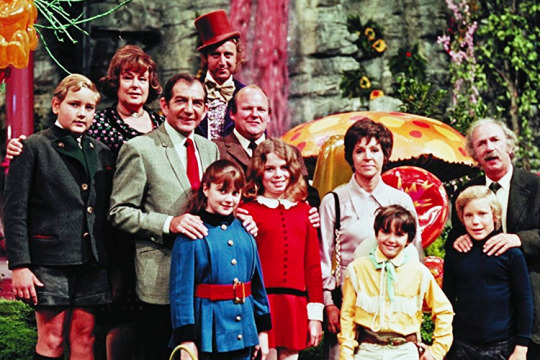
Image source: https://www.thedelite.com/willy-wonka-and-chocolate-factory-movie-facts-you-never-knew/
Filming came to a bittersweet end in November 1970, cast members said their teary goodbyes, and then seven months later, Willy Wonka premiered in the United States. While time has judged differently, the contemporary reception to the film was, at best, lukewarm. From a $2.9 million dollar budget, the film only made $4 million in theatres and ranked as #53 in the box office. There were a number of reasons for this. Several reviewers panned the movie; a critic from the New York Times called it ‘tedious and stagy with little sparkle and precious little humor’. The fun and spectacle of Willy Wonka didn’t sit well with an anxious and cynical audience. In the Vietnam era, The French Connection, The Omega Man, and A Clockwork Orange were in, and optimism and fun were out. The film also had to contend with the declining weekly movie attendance across the U.S, which reached an all-time low of 14 million in 1971 (from 44 million in 1963). On top of this, Dahl didn’t exactly enthuse about the final product. Finally - and this is what the director attributed primary responsibility to: a lacklustre marketing effort on behalf of Paramount Pictures.
But box-office results aren’t everything. Like sherbet - sour at first and then Oh so sweet, Willy Wonka has gone on to gain a mass following of fans and gained the all-desirable ‘cult’ film status. The phenomenon happened over time. Six years after the film appeared on cinema screens, it was sold to Warner Brothers and became one of their best-selling video cassettes. Then, periodic screenings on cable and network television over the following decades meant that it gained an even wider following and stayed within Western cultural consciousness. The never-ending references to Willy Wonka in popular culture - from The Simpsons to Austin Powers to Marilyn Manson’s music videos, is testament to this. The same could be said about the upcoming Willy Wonka origins story, whether it turns out to be a good film or not. Willy Wonka and the Chocolate Factory currently stands as the second most watched film of 1971 on Letterboxd (the Goodreads of film).
Re-watching the film in 2021, it seems almost inevitable that the film has found new and wide- ranging audiences and there’s one main reason for it: a stellar and totally captivating performance from Gene Wilder. The director attributed the film’s longevity to the fact that ‘it was made for adults; it was not made for children’ and it was Wilder himself that brought the grown-up fun. Wilder’s Wonka is sarcastic and witty, ensuring that the final film ended up as a ‘story for children’ only as much as After Eights are for post-dinner treats and Yorkie bars are just for boys. Wilder created a more nuanced and entrancing character out of Wonka than what is portrayed in the book - a Wonka who is dishonest but trustworthy, sarcastic but still empathetic, indifferent but deeply caring, and aloof but charming. Sure, the sets seem slightly dated (the chocolate room in particular) but watching Gene Wilder sing ‘Pure Imagination’ is so wholly captivating that one almost doesn’t notice the set’s limitations. Creating, let alone portraying, such an enigmatic version of Wonka is a tall order, but Wilder made it looks effortless. As evidence of his skill as an actor, Willy Wonka shows Charlie little interest until the very end of the film and then within minutes conveys a parental love to the boy that seems entirely believable. Wilder’s tantalising hot then cold, sugary then sour, sweet then salty performance sustains the whole film.
From the outset, it seemed like the Wilder-Wonka synergy was made to be. Wilder was a relative newcomer to Hollywood in 1970, making his feature film debut in the 1967 film Bonnie & Clyde, but when he walked into the casting room at the Plaza Hotel in New York, Mel Stuart knew he was the man straight away – ‘That’s Willy Wonka!’ he said. Wilder himself immediately seemed to have an intuitive understanding of how to bring the character to life, agreeing to take on the role on one condition: he said to Stuart, “I would like to come out [of the factory] with a cane and be crippled because no one will know from that time on whether I’m lying or telling the truth.’’ Like a magician, Wilder’s Wonka was going to draw you in and keep you in the palm of his hand. To the child actors on set, the Wilder-Wonka symbiosis was very much real. Julia Winter recalled that between takes the kids would crawl all over Wilder yelling, ‘It’s my turn to sit on his lap!’. In turn, Wilder would tell them jokes and stories; he ‘never got cross’. I remember feeling the same captivation as a child watching the film: I wanted to spend time with Wonka. It was only some adults who missed the magic trick. Dahl criticised Wilder’s performance as ‘pretentious’ and insufficiently ‘gay’. Wilder himself recalled hearing talk of mothers saying that the film was ‘cruel to the children’, but he understood that ‘maybe some mothers felt that way, but the children didn’t feel that way...there are limits and they want to know the limits’. The continuing classic status of the film is evidence that the kids (and Wilder) were right. The Wilder-Wonka magic has survived 50 years without souring. The only bittersweetness in watching the actor sing and twirl across the screen is knowing he is no longer with us.

Image source: https://cometoverhollywood.com/2016/08/29/musical-monday-willy-wonka-the-chocolate-factory-1971/
If Gene Wilder carried the film, then what about the story itself? The plot is simple, heart- warming, and doesn’t deserve close scrutiny. Willy Wonka really is a ‘show’, the story is secondary to the individual charisma of Wilder and the spectacle of the image and music. We don’t know if Charlie will be happy or sad once he’s inherited Wonka’s factory. We also don’t know what happens to the rest of the children after they’ve been punished. But who cares? The audience is taken to a joyful fun park where you want to eat everything on screen and play with all the gizmos and gadgets, and where the music is so catchy that you can’t get it out of your head for days and weeks after.
Select ideologues have (and will) taken issue with the story, discarding it as gauche capitalist propaganda. One Marxist criticism of the story even gained enough traction that the director took notice in later years. The parts seem to be there: a businessman running a competition by hiding five golden tickets in his candy bars, competition from other candy makers, the Wonka-Oompa Loompa relationship, and a ‘Rags to riches’ story for Charlie. But one might ask if this is an unnecessary and selective reading. The parts for an alternative vision are equally apparent: from the wild and uncontrolled creativity and experimentation inside the factory to the joy found within the chocolate work itself, and from the relentless drive forward ‘You have to go forward if you want to go back’ to the end picture of the elevator shooting through a glass ceiling and into the skies. If a critic really wanted to make the comparison, such images would sit more easily in Soviet Russia than capitalist America. Wonka might have a capitalist wrapper but take a bite and look closely inside and its ideological filling is incoherent (it is, after all, entertainment). One could imagine how the film might be set in a collectivist community rather than a ‘capitalist’ factory, but it would have made for a worse film. It is the sense of unease that runs throughout the film that has made it timeless, whether its Wonka’s frustration with August Gloop for polluting his pure chocolate river, his fear over someone leaking the secret recipe for the ever-lasting gobstopper, his nightmares in the tunnel sequence, or his anxiety over finding a worthy heir for the factory, which finally manifests as a misjudged outburst at Charlie. It’s the fraught relationship between abundance and greed that makes for such compelling watching. Anyway, as the screenwriter stated in an interview, the film is ‘...not the function of sitting down and intellectualising... it’s the function of scotch tape, cardboard, let’s put on a show!’ Why spoil the fun and examine the parts individually when the sum of the parts is a universal message people need to hear now as much as they did in 1971? Reward honesty and integrity, not greed.
A moral message delivered in an almost subversive tone is another reason for why the film feels timeless. Instead of adults dragging tired and bored children around, the adults in this film are at the mercy of their kids and Wonka. Young viewers can marvel at the gluttony of August Gloop, the smart-mouthed Violet Beauregarde, the wanton bad behaviour of Veruca Salt, and Mike Teevee’s devotion to cable. It’s escapism at its best to watch other kids do what you can’t do: speak back to parents and yell and scream. It’s equally as tantalising when the naughty children are punished in fantastical ways. Augustus, drinking from the chocolate river, falls in and then gets sucked up a chocolate chute. Violet chews forbidden gum and then blows up into a blueberry the size of a small horse. Veruca falls down a garbage chute. And Mike finds himself sucked into a television. Best of all, the parents are equally guilty of bad-behaviour as the kids - and, boy, do they pay for it. Wonka might be a film for children and adults, but you can guess who’s going to really have the best time. It is little Charlie, after all, who wins Wonka’s factory at the end of the day.
In the scene where Willy Wonka drinks from a yellow flower-shaped cup and then eats the cup, the cup itself was made of wax. Gene Wilder had to chew the wax pieces until the end of the take, at which point he spat them out. Adults that once watched the film as children now know that flowers in the garden aren’t edible. Our eyes can pick up the small imperfections in the film - the sweets that look plastic and chocolate river that looks like exactly what it was - ‘dirty, stinky water’. But through a child’s eyes - even coming to the film half a century after its release, the film really can be a ‘world of pure imagination’. In another fifty years, will children still wander into the garden, pick up a buttercup, and bite into it with all the belief in the word that it’ll taste like sweet, white chocolate? As long as parents continue to show children the film, they will - and what a marvellous legacy for a film to have. Fifty years on, it’s safe to say that Willy Wonka has had a sweet and indelible impact on our sadly mostly inedible world.
Sources for post:
Mel Stuart, Josh Young, ‘Pure Imagination: The Making of Willy Wonka and the Chocolate Factory’, 2001.
Julia Dawn Cole, ‘I Want It Now! a Memoir of Life on the Set of Willy Wonka and the Chocolate Factory’, 2011.
Pure Imagination: The Story (Making) of Willy Wonka & The Chocolate Factory: https://www.youtube.com/watch?v=0yyev_3S_Y4
----
© Fifty Year Films, 2021. Unauthorized use and/or duplication of material from this blog without express and written permission from this site’s author is prohibited. Excerpts and links may be used, provided that full and clear credit is given to Fifty Year Films with appropriate and specific direction to the original content.
22 notes
·
View notes
Text
Anonymous asked: I really enjoyed your book review of Sebastian Junger’s Homecoming. Perhaps enjoyment isn’t the right word because it brought home some hard truths. Your book review really helped me understand my older brother better when I think back on how he came home from the war in Afghanistan after serving with the Paras and had medals pinned up the yin yang. It was hard on everyone in the family, especially for him and his wife and young kids. He has found it hard going. Thanks for sharing your own thoughts as a combat veteran from that war. Even if you’re a toff you don’t come across as a typical Oxbridge poncey Rupert! As you’re a classicist and historian how did ancient soldiers deal with PTSD? Did the Greeks and Roman soldiers even suffer from it like our fighting boys and girls do? Is PTSD just a modern thing?
Part 1 of 2 (see following post)
Because this is subject very close to my heart as a combat veteran I thought very long and hard about the issues you raised. I decided to answer this question in two posts.
This is Part 1 and Part 2 is the next post.
My apologies for the length but this is subject that deserves full careful consideration.
Thank you for your lovely words and I especially find its heart warming if they touched you. I appreciate you for sharing something of the experience your ex-Para brother went through in coming home from war. I have every respect for the Parachute regiment as one of the world’s premier fighting force.

Working alongside them on missions out in Afghanistan I could see their reputation as the ‘brain shit’ of the British Army was well deserved. They’re most uncouth, sweary, and smelliest group of yobbos I’ve ever had the awful misfortune to meet. I’m kidding. The mutual respect and the ribbing went hand in hand. I doff my smurf hat to the cherry berries as ‘propah soldiers’ as they liked to say especially when they cast a glance over at the other elite regiments like HCav and the guards regiments.

Don’t worry I’ve been called a lot worse! But I am grateful you don’t lump me with the other ‘poncey’ officers. Not sure what a female Rupert is called. The fact that I was never accused of being one by any of those I served with is perhaps something I take some measure of pride. There are not as many real toff officers these days compared to the past but there are a fair few Ruperts who are clueless in leading men under their charge. I knew one or two and frankly I’m embarrassed for them and the men under their charge.
I don’t know when the term PTSD was first used in any official way. My older sister who is a doctor - specialising in neurology and all round brain box and is currently working on the front lines in the NHS wards fighting Covid alongside all our amazing NHS nurses and doctors - took time out one evening to have a discussion with me about these issues. I also talked to one or two other friends in the psychiatric field too. In consensus they agree it was around 1980 when the term PTSD came into usage. Specifically it was the third edition of the Diagnostic and Statistical Manual of Mental Disorders (DSM-lll) published by the American Psychiatric Association in 1980 partly because as a result of the ongoing treatment of veterans from the Vietnam War. In the modern mind, PTSD is more associated with the legacy of the Vietnam War disaster.

The importance of whether PTSD affected the ancient Greeks and Romans lies in the larger historical question of to what extent we can apply modern experience to unlock or interpret the past. In the period since PTSD was officially recognised, scholars and psychologists have noted its symptoms in descriptions of the veterans of past conflicts. It has become increasingly common in books and novels as well as articles to assume the direct relevance of present-day psychology to the reactions of those who experienced violent events in the historical past. In popular culture, especially television and film dramas, claims for the historical pedigree of PTSD are now often provided as background to the modern story, without attribution. Indeed we just take it as a given that soldier-warriors in the past suffered the same and in the same way as their modern day counterparts. We are used to the West to map the classical world upon the present but whether we can so easily map the modern world back upon the Greeks and Romans is a doubtful proposition when it comes to discussing PTSD.
Simply put, there is no definitive evidence for the existence of PTSD in the ancient world existed, and relies instead upon the assumption that either the Greeks or Romans, because they were exposed to combat so often, must have suffered psychological trauma.
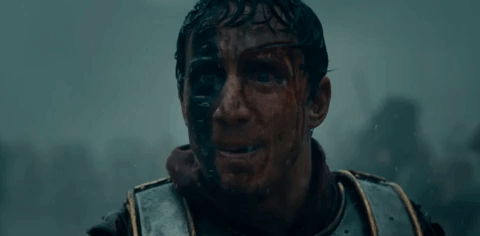
There are two schools of thought regarding the possibility of PTSD featuring in the Greco-Roman world (and indeed the wider ancient world stretching back into pre-history, myth and legend) – universalism and relativism. Put simply, the universalists argue that we all carry the same ‘wetware’ in our heads, since the human brain probably hasn’t developed in evolutionary terms in the eye blink that is the two thousand years or so since the Greco-Roman Classical era. If we’re subject to PTSD now, they posit, then the Greeks and the Romans must have been equally vulnerable. The relativists, on the other hand, argue that the circumstances under which the individual has received their life conditioning – the experiences which programme the highly individual software running that identical ‘wetware’, if you will – is of critical importance to an individual’s capacity to absorb the undoubted horrors of any battlefield, ancient or modern.
Whichever school one falls down on the side of is that what seems to happen in any serious discussion of the issue of PTSD in the ancient world is to either infer it indirectly from culture (primarily, literature and poetry) or infer it from a comparative historical understanding of ancient warfare. Because the direct evidence is so scant we can only ever infer or deduce but can never be certain. So we can read into it whenever we wish.
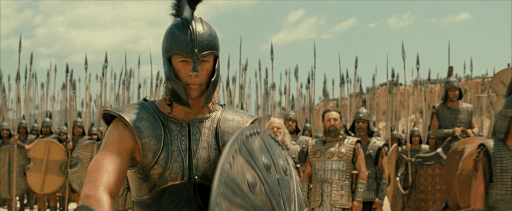
In Greek antiquity we have of course The Illiad and the Odyssey as one of the most cited examples when we look at the character traits of both Achilles and Odysseus. From Greek tragedy those who think PTSD can be inferred often point to Sophocles’s Ajax and Euripide’s Heracles. Or they look to Aeschylus and The Oresteia. I personally think this is an over stretch. Greek writers do; the return from war was a revisited theme in tragedy and is the subject of the Odyssey and the Cyclic Nostoi.
The Greeks didn’t leave us much to ponder further. But, with rare exceptions, the works from Graeco-Roman antiquity do not discuss the mental state of those who had fought. There is silence about the interior world of the fighting man at war’s end. So we are led to ponder the question why the silence?
This silence also echoes into the Roman period of literature and history too. Indeed when we turn to the Roman world, descriptions of veterans are rare in the writings that survive from the Roman world and occur most often in fiction.
In the first poem of Ovid’s Heroides, the poet writes about a returned soldier tracing a map upon a table (Ov. Her. 1.31–5):
...upon the tabletop that has been set someone shows the fierce battles, and paints all Troy with a slender line of pure wine:
‘Here the Simois flowed; this is the Sigeian territory,
here stood the lofty palace of old Priam, there the tent of Achilles...’
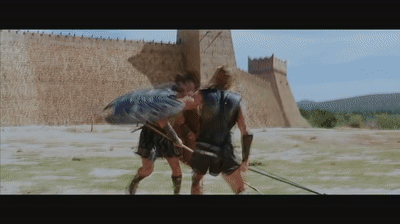
This scene provides an intimate glimpse of what it must have been like when a veteran returned home and told stories of his campaigns: the memories of battle brought to the meal, the crimson trail of the wine offering a rough outline of the places and battlefields he had experienced. The military characters in poems and plays show a world in which soldiers are ubiquitous, if somewhat annoying to the civilians. Plautus, for instance, in his Miles Gloriosus, portrays an officer boasting about his made-up conquests – the model for the braggart in A Funny Thing Happened on the Way to the Forum – and Juvenal complains about a centurion who stomps on his sandalled foot in the bustling Roman street.
Despite this silence, compelling works have been written that interweave vivid modern accounts of combat and its aftermath with quotes from ancient prose and poetry. At their best, these comparisons can illuminate both worlds, but at other times the concerns of the present-day author are imposed on the ancient material. But the question remains are such approaches truthful and valid in understanding PTSD in the ancient world?

So if arts and literature don’t really tell us much what about comparative examples drawn from military history itself?
Here again we are in left disappointed.
According to the Greek historian, Herodotus, in 480 B.C., at the Battle of Thermopylae, where King Leonidas and 300 Spartans took on Xerxes I and 100,000-150,000 Persian troops, two of the Spartan soldiers, Aristodemos and another named Eurytos, reported that they were suffering from an “acute inflammation of the eyes,”...Labeled tresantes, meaning “trembler,”. It is that Aristodemos later hung himself in shame. Another Spartan commander was forced to dismiss several of his troops in the Battle of Thermopylae Pass in 480 B.C, “They had no heart for the fight and were unwilling to take their share of the danger.”
Herodotus again in writing about the battle of Marathon in 490 B.C., cites an Athenian warrior who went permanently blind when the soldier standing next to him was killed, although the blinded soldier “was wounded in no part of his body.” Interestingly enough, blindness, deafness, and paralysis, among other conditions, are common forms of “conversion reactions” experienced and well-documented among soldiers today
Outside the fictional world, Roman military history tell us very little.
Appian of Alexandria (c. 95? – c. AD 165) described a legion veteran called Cestius Macedonicus who, when his town was under threat of capture by (the Emperor-to-be) Octavian, set fire to his house and burned himself within it. Plutarch’s Life of Marius speaks of Caius Marius’ behaviour who, when he found himself under severe stress towards the end of his life, suffering from night terrors, harassing dreams, excessive drinking and flashbacks to previous battles. These examples are just a few instances which seem to demonstrate that PTSD, or culturally similar phenomena, may be as old as warfare itself. But it’s worth stressing it is not definitive, just conjecture.
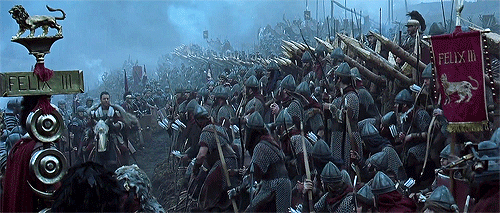
Of course of accounts of wars and battles were copiously written but not the hard bloody experience of the soldier. Indeed the Roman military man is described almost exclusively as a commander or in battle. Men such as Caesar who experienced war and wrote about it do not to tell us about homecoming.
It seems one of main challenges when we try to see military history through the lens of our definition of PTSD is to first understand the comparative nature of military history and what it is we are comparing ie mistaking apples for oranges.
The origin of military history was tied to the idea that if one understood ancient battle, one might fight and, more importantly, one might lead and strategise more effectively. In essence, much of the training of officers – even in the military handbooks of the Greeks and Romans – was an attempt to keep new commanders from making the same mistakes as the commanders of old. Military history is intended to be a pragmatic enterprise; in pursuit of this pragmatic goal, it has long been the norm to use comparative materials to understand the nature of ancient battle.
The 19th Century French military theorist Ardant du Picq argued for the continuity of human behaviour and assumed that the reactions of men under the threat of lethal force would be identical over the centuries: “Man does not enter battle to fight, but for victory. He does everything that he can to avoid the first and obtain the second....Now, man has a horror of death. In the bravest, a great sense of duty, which they alone are capable of understanding and living up to, is paramount. But the mass always cowers at sight of the phantom, death. Discipline is for the purpose of dominating that horror by a still greater horror, that of punishment or disgrace. But there always comes an instant when natural horror gets an upper hand over discipline, and the fighter flees”
These words offer insight to those of us who have never faced the terror of battle but at the same time assume the universality of how combat is experienced, despite changes in psychological expectations and weaponry, to name but two variables.
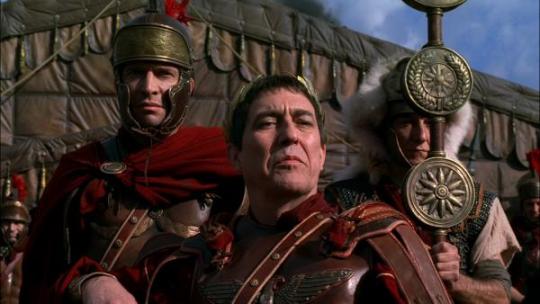
Another incentive for scholars and researchers is to turn to comparative material has been the growing awareness of the artificiality of how we describe war. A mere phrase such as ‘flank attack’ does not capture the bloody, grinding human struggle. Roman authors – especially those who had not fought – often wrote generic descriptions of battle. Literary battle can distort and simplify even as it tells, but if the main things are right – who won, who lost, and who the good guys are – the important ‘facts’ are covered. Even if one intends to speak the truth about battle, the assumptions and the normative language used to describe violence will affect the telling. We may note that the battle accounts in poetry become increasingly grisly during the course of the Roman Empire (perhaps owing to the growing popularity of gladiatorial games),while, in Caesar’s Gallic War, the Latin word cruor (blood) never appears and sanguis (another Latin word for blood) only appears in quoted appeals (Caes. B. Gall. 7.20, in the mouth of Vercingetorix, and 7.50, where the centurion M. Petronius urges his men to retreat). The realities of the battlefield are described in anodyne shorthand. In much the same way that the news rarely prints or televises graphic images, Caesar does not use gore, and perhaps for the same reason – to give a sense of reportorial objectivity.

Another element in the interpretive scrum is a given author’s goal in writing an account in the first place: Caesar, for example, was writing about himself, and he may have been producing something akin to a political campaign ad. Caesar makes Caesar look great and there is reason to believe that, if he was not precisely cooking the books, he did give them a little rinse to make him look more pristine. Given the many factors that complicate our ability to ‘unpack’ battle narratives, Philip Sabin has argued that the ambiguity and unreliability of the ancient sources must be supplemented by looking at the “form of the overall characteristics of Roman infantry in mortal combat”. Again the modern is used to illuminate that which is obscured by written accounts and the “the enduring psychological strains” are merely unconsciously assumed.
These legitimate uses of comparative materials have led to a sort of creep: because military historians have used observations of how men react to combat stress during battle to indicate continuity of behaviour through time, there appears to be a consequent expectation that men will also react identically after battle. This creep became a lusty stride with modern books written about the ancient world and PTSD.
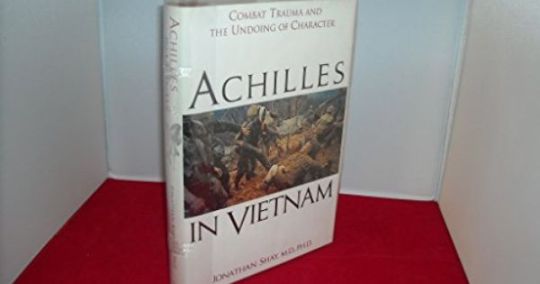
After I finished my tour in Afghanistan I read many books recommended to me by family and friends as well as comrades. One of these books is well known in military circles - at least amongst the thinking officer class - as an iconic work of marrying the ancient world and the modern experience of war. I read it and I was touched deeply by this brilliant therapeutic book. It was only months later I began to re-think whether it was a true account of PTSD in the ancient world.
This insightful book is called Achilles in Vietnam by Jonathan Shay. Shay is psychiatrist in Boston, USA. He began reading The Iliad with Vietnam veterans whom he was treating. Achilles in Vietnam, is a deeply humane work and is very much concerned with promoting policies that he hoped would help diminish the frequency of post-traumatic stress. His goal was not to explain ancient poetry but to use it therapeutically by linking his patients’ pain to that of the Iliad’s great hero. His book offers a conduit between the reader and the experiences of the men that Shay counsels. In the introduction to this work he makes a nod to Homerists while also asserting the primacy of his own reading:
“I shall present the Iliad as the tragedy of Achilles. I will not glorify Vietnam combat veterans by linking them to a prestigious ‘classic’ nor attempt to justify study of the Iliad by making it sexy, exciting, modern or ‘relevant’. I respect the work of classical scholars and could not have done my work without them. Homer’s poem does not mean whatever I want it to mean. However, having honored the boundaries of meaning that scholars have pointed out, I can confidently tell you that my reading of the Iliad as an account of men in war is not a ‘meditation’ that is only tenuously rooted in the text. “
After outlining the major plot points around which he will organise his argument, he notes, “ ‘This is the story of Achilles in the Iliad, not some metaphorical translation of it”.
The trouble was and continues to be is that many in the historical and medical fields began to rush to unfounded conclusions that Shay, on the issue of PTSD in the ancient world, had demonstrated that the psychological realities of western warfare were universal and enduring. More books on similar comparative themes soon emerged and began to enshrine the truth that PTSD was indeed prevalent throughout the ancient world and one could draw comparative lessons from it.

Perhaps one of the most influential books after Shay was by Lawrence Tritle. Tritle, a veteran himself, wrote From Melos to My Lai. It’s a fascinating book to read and there are parts that certainly resonate with my own experiences and those of others I have known. In the book Tritle drew a direct parallel between the experiences of the ancient Greeks and those of modern veterans. For instance, Xenophon, in his military autobiography, presents a brief eulogy for one of his fallen commanders, Clearchus. Xenophon writes that Clearchus was ‘polemikos kai philopolemos eschatos’ (Xen. An. 2.6) – ‘warlike and a lover of war to the highest degree’.
Tritle comments:
“The question that arises is why men like Clearchus and his counterparts in Vietnam and the Western Front became so entranced with violence. The answer is to be found in the natural ‘high’ that violence induces in those exposed to it, and in the PTSD that follows this exposure. Such a modern interpretation in Clearchus’ case might seem forced, but there seems little reason to doubt that Xenophon in fact provides us with the first known historical case of PTSD in the western literary tradition.”
Arguably in the West and especially our current modern Western culture is predicated at baulking at the notion of being ‘war lovers” as immoral. But such an interpretation speaks more of our modern Christianised ambivalence towards war; to the Spartans and Athenians the term would not have had a negative connotation. ‘Philopolemos’ is, in fact, a compliment, and the list of Clearchus’ military exploits functions as a eulogy. There are points where his analysis does not adequately address the divergences between ancient and modern experiences.

For all the talk of our Western culture being rooted in Ancient Greece and Rome we are not shaped by the same ethics. Our modern ethics and our moral code is Christian. There is no such thing as a secular humanist or atheist both owe a debt to Christianity for the way they have come to be; in many respects it’s more accurate to describe such people as Christianised Humanists or Christian Atheists even if they reject the theological tenets of the religious faith because they use Christian morality as the foundation to construct their own. Many forget just how brutal these ancient societies were in every day life to the point there would be little one could find recognisable within our own modern lives.
Now we come to third point I wish to make in determining where the Greeks or Romans actually experienced PTSD. This is to do with the little understood nature of PTSD itself. As much as we know about PTSD there is still much more we don’t know. Indeed one of the most problematic and complicated issues is the continued disagreement around the diagnosis and specific triggers of the disorder which remain little understood. We have to admit there are competing theories about what causes PTSD but, in terms of experiences that make it manifest, there are essentially three possible triggers: witnessing horrific events and/or being in mortal danger and/or the act of killing – especially close kills where the reality of one’s responsibility cannot be doubted. The last of these was strongly argued in another scholarly book by D. Grossman, On Killing, the Psychological Cost of Learning to Kill in War and Society (1995).
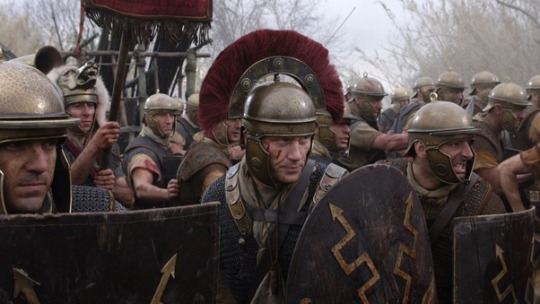
Roman soldiers had the potential to experience all of these things. The majority of Roman combat was close combat and permitted no doubt as to the killer. The comparatively short length of the gladius encouraged aggressive fighting. Caesar recounts how his men, facing a shield wall carried by the taller Gauls, leaped up on top of the shields, grabbed the upper edges with one hand, and stabbed downwards into the faces of their opponents (Caes. B. Gall. 1.52). As for mortal danger, Stefan Chrissanthos in his informative book, Warfare in the Ancient World: From the Rise of Uruk to the Fall of Rome, 3500BC-476AD, puts it this way: “For Roman soldiers, though the weapons were more primitive, the terrors and risks of combat were just as real. They had to face javelins, stones, spears, arrows, swords, cavalry charges, and maybe worst of all, the threat of being trampled by war elephants.”
Such terrors are regularly attested. During his campaign in North Africa, Caesar, noting his men’s fear, procured a number of elephants to familiarise his troops with how best to kill the beasts (Caes. B. Afr.72). It should also be noted that it was not unusual for the reserve line to be made up of veterans because they were better able to watch the combat without losing their nerve. Held in reserve, they had to watch stoically as their comrades were injured and killed, and contemplate the awful fact that they might suffer the same fate. This was not a role for the faint of heart.
However, while the Romans certainly had the raw ingredients for combat trauma, the danger for a Roman legionary was much more localised. Mortars could not be lobbed into the Green Zone, suicide bombers did not walk into the market, and garbage piled on the street did not hide powerful explosives. The danger for a Roman soldier was largely circumscribed by his moments on the field of battle, and even here, if he was with the victorious side, the casualties were likely to be light: at Gergovia, a disaster by Caesar’s standards, he lost nearly seven hundred men (Caes. B. Gall. 7.51). In his victory over Pompey the Great at Pharsalus, his casualties numbered only two hundred (Caes. B. Civ. 3.99).

So we are left with the disturbing question: were the stressors really the same?
This is the part where I also defer to my eldest sister as a doctor and surgeon specialising in neurology and just so much smarter than myself.
My eldest sister holds the view in talking to her own American medical peers that despite similar experiences in Afghanistan and Iraq, British soldiers on average report better mental health than US soldiers.
My sister pointed out to research study done by Kings College London way back around 2015 or so that analysed 34 studies produced over a 15-year period (up to 2015) and found that overall there has been no increase in mental health issues among British personnel - with the exception of high rates of alcohol abuse among soldiers. The study was in part inspired the “significant mental health morbidity” among U.S. soldiers and reports that factors such as age and the quality of mental health programs contribute to the difference between the two nation’s servicemen and women.
She pointed out that these same studies showed that post-traumatic stress disorder afflicts roughly 2 to 5% of non-combat U.K. soldiers returning from deployment, while 7% of combat troops report PTSD. According to a General Health Questionnaire, an estimated 16 to 20% of U.K. soldiers have reported symptoms of common mental disorders, similar to the rates of the general U.K. population. In comparison, studies around the same time in 2014 showed U.S. soldiers experience PTSD at rates of 21 to 29%. The U.S. Department of Veteran Affairs estimated PTSD afflicted 11% of veterans returning from Afghanistan and 20% returning from Iraq. Major depression was reported by 14% of major soldiers according to another study commissioned by RAND corporation; roughly 7% of the general U.S. population reports similar symptoms.
It’s always tough comparing rates between countries and is not a reflection of the quality of the fighting soldier. But one finding that consistently and stubbornly refuses to go away is that over the past 20 years reported mental health problems tend to be higher among service personnel and veterans of the USA compared with the UK, Canada, Germany and Denmark.
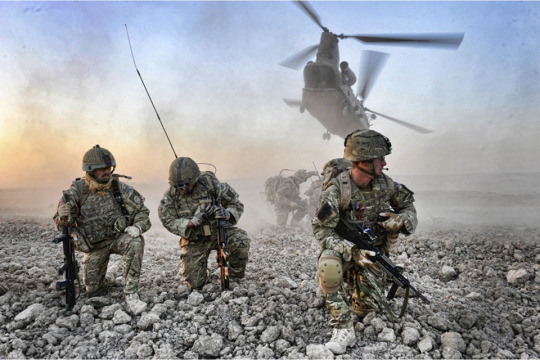
However my sister strongly cautioned against making hasty judgements. And there could be many variable factors at play. One explanation is that American soldiers are more likely than their British counterparts to be from the reserve forces. Empirical studies showed reservists from both America and British troops were more likely to experience mental illness post-deployment. It was also worth pointing out that American soldiers also tended to be younger - being younger and inexperienced as well as untested on the battlefield, service personnel would naturally run the risk of greater and be more vulnerable to mental illness.
In contrast, the elite forces of the British army, such as your brother’s Parachute Regiment or the Royal Marines, were found to be the least affected by mental illness. It was found that in spite of elite forces experiencing some of the toughest fighting conditions, they tended to enjoy better mental health than non-elite troops. The more elite a unit is or more professional then you find that troops tend to enjoy a very deep bonds of camaraderie. As such the social cohesion of these fighting forces provides a psychological protective buffer. Not for all, but for many.
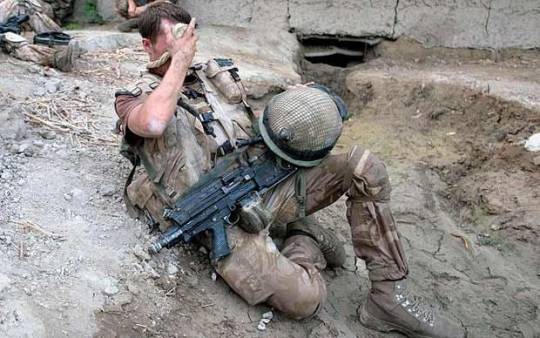
More intriguing are new avenues of discovery that might go a long way to actually understanding one of the root causes of PTSD. According to my sister, recent research carried out in the US and Europe and published in such prestigious medical journals as the New England Journal of Medicine (US) and the Lancet (UK), seems to establish a causal link between concussive injury and PTSD.
One recent study looked at US soldiers that concerned itself with the effects of concussive injuries upon troops after their return from active duty during the war in Iraq.
Of the majority of soldiers who suffered no combat injuries of any sort, 9.1 per cent exhibited symptoms consistent with PTSD. This allows a baseline for susceptibility of roughly 10% of the population. A slightly higher number (16.2%) of those who were injured in some way, but suffered no concussion, also experienced symptoms. As soon as concussive injuries were involved, however, the rates of PTSD climbed dramatically.
Although only 4.9% of the troops suffered concussions that resulted in complete loss of consciousness, 43.9% of these soldiers noted on their questionnaires that they were experiencing a range of PTSD symptoms. Of the 10.3% of the unit who suffered concussion resulting in confusion but retained consciousness, more than a quarter (27.3%) suffered symptoms. This suggests a high correlation between head trauma and the occurrence of subsequent psychological problems. The authors of the study note that ‘concern has been emerging about the possible long term effect of mild traumatic brain injury or concussion...as a result of deployment related head injuries, particularly those resulting from proximity to blast explosions’
Although these results are preliminary, if confirmed they have profound implications for anyone trying to understand the nature of warfare in the ancient world, especially the Western world.
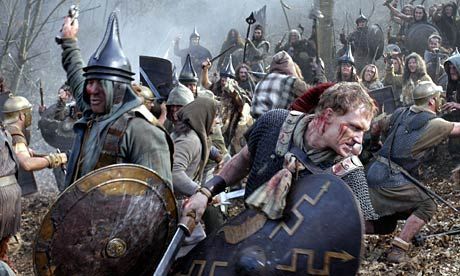
So why does it matter?
In Roman warfare, wounds were most often inflicted by edged weapons. Romans did of course experience head trauma, but the incidence of concussive injuries would have been limited both by the types of weapons they faced and by the use of helmets. Indeed the efficacy and importance of headgear for example can be deduced from the death of the Epirrote general Pyrrhus from a roof tile during the sack of Argos. It is likely that the Romans designed their helmets with an eye to blunting the force of the blows they most often encountered. Connolly has argued that helmet design in the Republican period suggests a crouching fighting stance (see P. Connolly, ‘The Roman Fighting Technique Deduced from Armour and Weaponry’, Roman Frontier Studies (1989). However my own view is that the change in helmet design may signal instead a shift in the role of troops from performing assaults on towns and fortifications when the empire was expanding (and the blows would more often rain from above) to the defence and guarding of the frontiers.
While the evidence is clear that concussion is not the only risk factor for PTSD, it is so strongly correlated that it suggests that the incidence of PTSD may have risen sharply with the arrival of modern warfare and the technology of gunpowder, shells, and plastic explosives. Indeed, accounts of shell shock from the First World War are common, and it was in the wake of that war that those observing veterans suspected that neurological damage was being caused by exploding shells.

For soldiers of the Second World War and down to our modern day, an artillery barrage is like an invention of hell.
As one American put it in his memoirs of fighting the Japanese at Peleiu and Okinawa, “I developed a passionate hatred for shells. To be killed by a bullet seemed so clean and surgical but shells would not only tear and rip the body, they tortured one’s mind almost beyond the brink of sanity. After each shell I was wrung out, limp and exhausted. During prolonged shelling, I often had to restrain myself and fight back a wild inexorable urge to scream, to sob, and to cry. As Peleliu dragged on, I feared that if I ever lost control of myself under shell fire my mind would be shattered. To be under heavy shell fire was to me by far the most terrifying of combat experiences. Each time it left me feeling more forlorn and helpless, more fatalistic, and with less confidence that I could escape the dreadful law of averages that inexorably reduced our numbers. Fear is many-faceted and has many subtle nuances, but the terror and desperation endured under heavy shelling are by far the most unbearable” (see E.B. Sledge, With the Old Breed at Peleiu and Okinanwa, 2007).

The psychological effect of shelling seems to result from the combined effect of awaiting injury while at the same time having no power to combat it.
There is another aspect that I alluded to above which is the psychological and societal conditioning of the Roman soldier. In other words a Roman male’s social and cultural expectations of his place in the world. Feelings of helplessness and fatalism were probably a less alien experience for most Romans – even those in the upper classes. In general, the Romans inhabited a world that was significantly more brutal and uncertain than our own.
This another way of saying that the Roman and 21st century combat are very different in a variety of ways that subject the modern soldier to a good deal more stress than the legionary was ever likely to suffer. And the Roman’s societal preparation – his life before the battle – was far more robust than that we enjoy today.
Take infant mortality. In the modern developed world, our infant mortality rates are about ten per thousand. In Rome, it is estimated that this number was three hundred per thousand. Three-tenths of infants would die within the first year, and an additional fifth would not make it to the age of ten - 50% of children would not survive childhood. Anecdotal evidence supports these statistics: Cornelia, the mother of the Gracchi, gave birth to twelve children between 163 bc and 152 bc; all twelve survived their father’s death in 152 bc, but only three survived to adulthood. Marcus Aurelius and his wife, Faustina, had at least twelve children but only the future emperor Commodus survived.
Then look at how that child grows up. The typical Roman child would be raised in a society that readily accepted ultra-violent arena entertainment, mob justice, frequent and bloody warfare as a fact of life. This was reinforced by religious and societal encouragement to see war as natural and beneficial, open butchering of food animals, a total lack of support structures for the poor and less able.

Compared to the legionary our modern soldier has been protected from such realities to a greater degree than at any other point in history, and will thus be far less well prepared for the horror of a warfare that contains far more stress factors than for a man who might fight a handful of battles in his military career, with long periods of relative calm in between, state of war notwithstanding. Modern special and elite forces training often emphasises the brutalisation and ‘rebuilding’ of the recruit in readiness for this step into darkness, but it seems likely that no such conditioning would have been needed two thousand years ago.
I would argue that we experience war very differently from the way the Romans did. Our modern identity is defined far more by our Western Christian heritage than our Western Classical roots. They are in fact world apart when it comes to ethics and morality. Consider the fact that when we talk of war and killing today we often do so through conflict between our civilian moral codes – which offer the strict injunction not to do violence to other human beings – and wartime, when men are commanded to violate such prohibitions. It is a terrible thing to try to navigate ‘Thou shalt not kill’ and the necessity of taking a life in combat.
It is sometimes the case that the qualities that make the best soldier do not make the best civilian, a point amply attested in Greek poetry by heroes such as Heracles and Odysseus.

The Romans, for their part, celebrated heroes such as Cincinnatus, who could command effectively and then leave behind the power he wielded to return to his humble plough. It is important, however, when evaluating combat and its effects in the ancient world, that we do not read our ambivalence about violence onto the Romans. They inhabited an empire whose prosperity was quite openly tied to conquest.
As M. Zimmerman writes in his academic article, “Violence in Late Antiquity Reconsidered’ (2007), “The pain of the other, seen on the distorted faces of public and private monuments, or heard in the screams of criminals in the amphitheatre, reassured Romans of their own place in the world. Violence was a pervasive presence in the public space; indeed, it was an important basis for its existence, pertaining as it did not only to victories over external enemies but also to the internal order of the state.”

Violence then was both the means and the expression of Roman power. The Roman soldier was its instrument. The Roman warrior then would have brought a different perspective to lethal violence, and would have had a far more restricted moral circle to his modern counterpart – his friends and family, clan, patron and clients, as opposed to millions of fellow citizens via the internet and social media.
Part II follows next post
#question#ask#PTSD#war#roman#greek#classical#legionary#spartan#mental health#depression#trauma#warfare#british army#mental illness#homecoming#soldiers#combat veterans#veterans
46 notes
·
View notes
Text
UC 51.03 - London Business School vs Hertford, Oxford
Since it was introduced at the 1988 Olympics, every single Gold Medal in the Women’s Team event in the Archery has gone to South Korea. Including yesterday’s win that’s nine straight victories, and their period of unparalleled dominance continues. The men’s team have also won six of the nine they have contested, and a mixed team won the first staging of that event in Tokyo too. Adding their success in the individual events, South Korea have won 26 gold medals, and 42 in total, in the 43 archery events which have been thus far staged at the Olympic Games.
As Twitter’s own @tarequelaskar pointed out in the brilliant article which alerted me to this story, this is a perfect example of specialisation, an economic concept whereby countries or companies focus intensely on one particular aspect of a given industry and come to serve that niche in such a specialised fashion that they become the ultimate experts and nigh-on irreplaceable. This is done in government and business by providing companies with incentives to specialise, and supporting those who succeed at it.
With respect to Korean archery, similar forces are at play. There are a bunch of professional teams and leagues in the country, giving archers financial stability while they focus on their training, something not as common across the world. Said training involves such things as practicing in live baseball stadiums and replicas of the Olympic venues, to mimic first the atmosphere and then the conditions that will be present on the day of the actual tournament.
This philosophy of marginal gains - the same system used by Team Sky and Chris Froome to win multiple Tour De Frances on the trot - puts their preparation miles ahead of the competition, which goes some way to explaining their dominance. It is not the only reason. Before the fine-tuning of the elite shooters comes the discovery of the promising young ones, and the inspiring nature of past success (along with a historic national love of the sport) helps to create a virtuous cycle which give Korea a far larger number of archers to choose from than any other country. This greater choice means that there is a greater chance of finding the next Gold medallists.
Making the argument that professional footballers are at a higher level than other elite sportspeople, Michael Cox used this same argument in a recent article for The Athletic. To summarise, he stated that because there are a far higher number of people who wish to become professional footballers, that must mean that the ones who do make it are at a higher standard than those who make it in other sports. Initially, I was drawn in by the pure maths of this point, but having thought about it some more I’m no longer sure to what extent I agree.
Now, the fact that hundreds of millions more people play football than rugby, or basketball, will certainly confer some level of “eliteness”, but only up to a certain point. Because football has been so popular for so long, the general standard of the play, relative to what it used to be, has had longer to improve. In the same way that if you transplanted a 100m runner from the Olympic final in the early 20th century to now they probably wouldn’t even qualify for the games, a footballer from the 80s would stand less of a chance of making it were they playing today. Many other sports don’t have that level of natural progression, afforded by decades of technical and tactical advancement - at least not globally.
But the numbers argument only goes so far, as can be demonstrated by the Korean archers. Yes, there are more archers in Korea than anywhere else, relatively, giving them a higher chance of uncovering those with a natural aptitude, but the reason behind their bow and arrow dynasty is the specialisation. The hyper-detailed level of training and focus which allows them to be the best they can possible be.
Now, archery is unique in that there is a theoretical maximum score (I understand that this is to some extent arbitrary, and related to the rules of the game as defined by some human being, semi-randomly, but it works in terms of this argument, because it gives a percentage score of how good the archers are based on the agreed-upon parameters of the sport), which, at the Olympics, is 720. The Olympic record is 700 (held by Korean Kim Woo-jin, giving an implied “eliteness level” of 97.2%.
The best player in the history of football (don’t @ me) is Lionel Messi, and few would doubt that he operates at or above that level of perfection in his sport. But I also don’t think you could doubt that Novak Djokovic, or Serena Williams in her pomp, were similarly magnificent at tennis. Cyclists on the Tour De France put their bodies through more in three weeks than most people endure in a decade, and have every aspect of their training and diet strictly controlled so as to bring them as close to perfection as possible. There will certainly be a higher number of these elite performers in football, because there are a higher number of paying jobs for said elite performers, and because more people attempt to become elite performers, but I don’t think that it follows on from that that they are better at their sport than other elite athletes, all of whom have undergone years and years of specialised training to get them where they are.
Does any of this matter, in terms of how each sport should be enjoyed? Probably not, but its interesting to think about, and kind of awe-inspiring to try and appreciate just how good those at the top of their respective games are. And if there is some discrepancy in the level of eliteness between the different sports it doesn’t detract from the fact that they would handily dispatch any civilian challengers without breaking a sweat. The joy comes from watching people who are good at stuff doing that stuff - and, as evidenced by the crowds which gather for non-league football, it doesn’t matter whether or not they are at the absolute pinnacle of said stuff. They’re still going to be much better than the rest of us.
Competitive quizzing is different from the activities previously mentioned in that any normal person can have a guess at pretty much any question, with a chance that they’ll get it right. What sets the contestants apart on shows like University Challenge is the speed of their recall under pressure - the quickness of their knowledge as well as the knowledge itself. But there are plenty of armchair quizzers who think they could wipe the floor on the show, so just how good are the actual contestants? (Compared to an elite footballer or archer on an imaginary scale that accounts for relative skill in all disciplines?). I don’t know (and in case you hadn’t noticed by now I’m just fascinated by people who are really good at anything, and wanted to share some of that fascination with you all), but I’ll try and have a go at answering it anyway.
So, the World Quizzing Championships have been dominated by British and Irish quizzers since its inception in 2003, with 16 of the 18 winners coming from either Britain or the Republic of Ireland (who have four wins courtesy of The Egghead Pat Gibson). This, in my mind, makes this neck of the woods comparable to South Korean archery. It is a hotbed of talent, and the infrastructure is in place to encourage and aid talent maximalisation. Indeed, if you scroll down the list of highest ranking players at the WQC in any given year you can see a significant cohort of UC alums, so clearly there are a number of elite quizzers who have passed through the show.
This specialisation can be seen in microcosm with the preponderance of top-level quizzers produced by Oxford and Cambridge, who both have a long-standing culture of competitive quizzing far beyond other Universities. The debate is there to be had on the fairness of each institution having so many teams, but clearly they produce enough elite players to compete with far bigger Unis when entering as (sometimes tiny) colleges.
In conclusion, I think it is pretty obvious that UC is a breeding ground for world-class quizzers, and though no one has won a World title straight off the bat after appearing on the show, there are top-50 and top 100 finishes abound, which is still greatly impressive, and helps to give an idea of just how good these students really are.
Hoping to justify the 1000 words I’ve just written about their exceptional talents are two teams from the London Business School and Hertford College, Oxford. The Oxford side have never made it beyond the second round, but LBS reached the semi-finals in 2006, their only previous appearance on the show. Anyway, there is quite literally no time for me to recite the rules; here’s your first starter for ten...
Paxman mentions that LBS were in the show in 2006, but doesn’t mention that they reached the semi final, which is lazy imo. A bunch of them are studying for MBAs, which makes sense. He doesn’t mention Hertford’s previous appearances either, but that’s more understandable.
Hertford’s Hitchens takes the first starter with Kennedy, and the Oxonians added a full set of bonuses on words made up by authors - including a couple of educated guesses. LBS hit back with the next question, but can only manage one bonus on famous scientists. One of the two they miss is Rosalind Franklin, and Paxman teases them for not spotting an apparently obvious clue within the question.
The first picture round is on national emblems, and LBS are first to recognise that of Vietnam for the starter. They don’t know Laos or Belarus, but do know that Mozambique has a machine gun on its one. Butterworth then jumps the gun with argon on the next starter, giving his answer just as Paxman says it in the question. Butterworth makes up for it with the music starter, recognising Fat Boy Slim before anyone else, and LBS know Primal Scream and Wu Tang Clan too. They’re still fifty points behind though, and will need a big second half to turn things around.
This task gets more difficult for them, as Hitchens takes another starter. Lloyd adds a second in a row for Oxford and they are nearly one hundred points clear. LBS really need to get some points on the board, and Ruess duly obliges, knowing that there is a massive sculpture of a spider called Maman, which sounds needlessly scary, to the extent that I’m not even going to google it.
The comeback is ended before its even begun as Oswald takes a starter for Hertford, which gives them the picture bonuses - the starter having been dropped by both teams. Lloyd produces another excellent guess of Reuben, demonstrating how useful it is to have vague knowledge as well as specific knowledge. This is one of probably five questions he has answered in a throwaway manner, but which turned out to be correct.
By this point LBS seem to have accepted defeat. Ruess takes another starter, but there is little to no urgency on the bonus questions. They’re right, granted, to have none, they have no chance of winning, but if they gave it a go they might scrape a high scoring loser spot. Ruess is the only one who seems bothered, and bags himself ten more points. They have an amusing discussion about methods of poisoning in Agatha Christie novels (’it was used as a curry ingredient?’, Ruess wondered aloud, trying to figure out which spices could be poisonous, before Butterworth pointed out that it wasn’t something commonly used as a curry ingredient, prompting respectful mirth from the audience) on the bonuses, but still languish miles behind.
Lloyd grabs the last starter of the night for Hertford, who win by eighty at the gong.
Final Score: London Business School 100 - 180 Hertford, Oxford
At the end, Paxman mentions Hertford’s stellar guesswork, which means I wasn’t chatting nonsense (at least on that front, the jury is out on the rest of it), and says that they’ve done a really good job. Incredibly effusive praise for a score of 180. He really is going soft in his old age.
Phew, that was a long one. If you made it through the intro you deserve a prize. And that prize is that you get to come back next week for the next episode of this blog!! Woop woop!
And if this wasn’t quite enough UC content for you then you can subscribe for extra blogs on my Patreon, which features Retro Reviews from the 2015/16 series of the show. Ta x
7 notes
·
View notes
Text

TITLE: No One To Save That Can't Be Saved
RATING: Teen and Up
CATEGORY: M/M
TAGS: COTTA 2020, Carry On Through The Ages, Murder, Murder Mystery, TW: Blood, tw: PTSD, POV Simon Snow, Simon Snow Has PTSD - Post-Traumatic Stress Disorder, Simon Snow Needs a Hug, Vietnam War, Counterculture hippie movement, 1960s, Counter Culture Movement, Simon Snow is a P.I., War Vet Simon Snow, Southern Belle Agatha, Feminism, Civil Rights Movement, Black Panther Shep, Feminist Penny, sexual revolution, Summer of Love - Freeform, 1967 San Francisco, Jazz Club Owner Baz, TW: War Flashback, tw: death, Haight-Ashbury Revolution, LGBTQ Revolution
SUMMARY: Simon Snow is not interested in any revolution.
Living in San Francisco, he sees the people marching everyday, for freedom, equality, for their voices to be heard.
He's just trying to survive day by day, living with the memories of his time in Vietnam, while trying to make ends meet, working as a Private Investigator.
His life changes one day, when a passionate young woman bursts into his office, demanding his help to bring justice to her friends who've been viciously murdered.
When Simon accepts this case, he is soon thrust into the middle of a Revolution that will see the world change for the better. He will soon see that nothing is what it seems, and his prior prejudices will be tested and broken.
And he'll be forced to face not only the truth of the world around him, but the sad, broken eyes of the person he left a long time ago.
:readmore:
A/N: First of all, I am overwhelmed with the amount of love that @carryonthroughtheages has received. To everyone who posted content, reblogged, spread the world and love, thank you from the bottom of my heart. This first year of COTTA was a massive success, and I cannot wait to do this again next year!
Next, thank you so so SO much to everyone who have been so supportive of me writing this fic. I had changed my idea halfway through the writing period and was worried that I would not have anything to post. But thank you to those who held my hand and supported me.
@hufflepunky for being my number one history researcher! Thank you for spending endless hours with me, going over research and for answering my questions about San Francisco life and lingo. Also thank you for being just such an amazing friend. I love you, sis!
@amywaterwings thank you for constantly holding me accountable for my story and my words. You are persistent and you are willing to call me out on my distraction excuses. I adore you and love you. Thank you for being being my mental rock during this last month in particular. Love you so much!
@carryonsimoncarryonbaz , you are the person I look up to the most. You love and support for everything I do means the absolute world to me. Thank you for being the most amazing Beta anyone could ask for, and for showing my fic the love and hype it deserves. Thank you for pushing me to keep writing and to never give up. Thank you for reminding me that I have a GOOD story to tell.
@giishu , for being one of the first people I shared my COTTA idea with, and for literally screaming in chat, and threatening me that I HAD to go through with me. SO yeah... thank Giishu for COTTA actually happening. If it weren't for their shouting and enthusiasm, I may not have gone through with it. Thank you for also being an amazing Beta, who is never afraid to point out my many many plot holes, and my unclear descriptions.
@foolofabookwyrm , for being my Brain Cell Mate, and for just being the best person. You love and friendship mean the world to me. Thank you for supporting me through my decision to change COTTA ideas. Thank you also for creating the fancy workskin I'm using and for teaching me how to code my fic so that it looks cool and fancy-like. (Also thank you for forcing me to watch Hamilton... The musical has left me hopeleeeeeess!)
A note on this fic... It is VERY different than the type of stuff I usually write. It's a lot darker and grittier. I wanted to fit the mood of a typical film noir. With that being said, there will be some violent scenes, as well as mentions of blood and injuries.
Also, as this fic is taking place during a very tumultuous time, I have tried to depict the atmosphere of 1967 San Francisco as respectfully as I could.
Finally, Simon is a Vietnam War vet. Just a small Google search will tell you that the Vietnam War was brutal for all parties involved. A lot of people died horrifically, and in vain. I have tried to depict his PTSD as respectfully and as truthfully as I could.
#cotta 2020#carry on through the ages#simon snow#carry on#my writing#contemporary Au#historical au#historical fanfiction#1960s murder mystery
61 notes
·
View notes
Note
I guess this isn’t really a writing question per-say, but you’re so knowledgeable on so much which I think is amazing. My question is, how did you even start? Like, was there a specific Avenue you jumped into? There’s just so much out there ya know? Also...love your blog to bits! 😱😱
I just really loved stories growing up and that went on to learning about history. I loved watching Horrible Histories (and yes I can rap /sing most of those songs) as a child and history was my favourite subject at school. I began reading short historical fiction books in school for fun called My Story which were a collection of fictional diaries written by young girls in different time periods.
I don't think i got really into history until my third year in Secondary (High School) where I decided in pure ME-fashion to take on a new extra subject in the middle of the exam year. The Principal & History teacher basically said to me "if you want to do it fine, we'll give you the book but you're wasting your time because there is no possible way for you to study 3 years of history in six months so... Go off i guess". First things first, I can be an incredibly lazy person but this time spite motivated me. And secondly, there was this girl who copied my idea to take up another subject & she got comperive with me real fast. I mean we've left school over 4 years ago and she still brings up the 1 time she got 5% more on an English Essay. Spite drove me to study history like my life depended on it. Cue me drilling myself in history every night for 2 hours (which by the way included the American Revolution, the Reformation, the Renaissance, the Viking era, the Industrial Revolution, the Vietnam & Korean Wars, both World Wars, Medieval Ireland, Ancient Rome, the Megalithic era, the Celtic era, the Troubles, the Irish Civil War & not to mention every fucking revolution, rebellion and rising in Irish history of which there are a lot because the English couldn't stop invading us for like 5 mins). Three months into this, the history teacher who has not offered me one ounce of help at this time turned around to be and was like, "you have to take the winter exam before we add you to the official list". And you bet your sweet ass that I fucking nailed that test. Her own class was averaging a solid C - D. I pull out an A. You cannot imagine the satisfaction I felt when this bitch came up to me and offered me her help after telling me I could not do it. I turned her help down and I did very well in the State Exam, very smugly if I say so myself.
But history has always been my jam. From being obessesed with Ancient Egypt as a kid to spending lockdown reading tomes of biographies and anthologies, I am never happier when learning about the world we have left behind.
21 notes
·
View notes
Note
hi! can i request an ahk x reader fic where reader was an air force pilot for some time and they and ahk exchange war stories? not to glorify war or anything but i’m interested to see how that would play out. thanks!
notes: hey! sorry that this might be a bit late, i was spending the day with my friend and had to write the bulk of it before 11.30 and i woke up at 9. sorry I kind of strayed from the prompt, but i hope you like it anyway
WC: 1.5k
+
He hadn't ever considered himself a survivor of a war. Fighting and death came so natural to him, and to many of the people from his time – simply put, it was as unavoidable as death, and would live for just as long. That being said, your logic did make sense; he was still a participant in a war, no matter how small it was.
"Did you stay to fight?" You asked in your soft, low voice. Every now and then he wondered if that's what you sounded like when you were alive.
"I was fifteen at the time, so no," he said with a chuckle, earning naught but a bittersweet smile. "In later years I did, though. My brother and I had rule over our own separate battalions. When it came time for us to make our move against the Nubians, I couldn't do it. I tried to hurt someone, but it's hard when you see their face, and you think of their mothers."
"War has changed a lot since then," you hummed, nodding thoughtlessly along to his story. "I didn't see a single person's face."
"How?"
"Remember Amelia?"
"Oh, yes," he said, recalling her flying contraption.
"You drop bombs from there that explode with fire, and depending on the size, a single bomb could kill thousands," you said as your voice once more turned soft, memories playing out behind your eyes.
It was true that Ahk had trouble picturing modern warfare. The methods that lasted eons were still imprinted in his mind, and as hard as he tried to imagine it, he still had difficulty. Planes that crowded the sky. Tanks that rolled over hills and mountains. Deep trenches and gunpowder. Chemicals and bombs. You thought to show him a movie – something more modern, not from your time, where the special effects would be better and the picture clearer. The first time you suggested it he turned you down, but perhaps he'd changed his mind.
"I could show you one of those movies," you said, watching his expression carefully for any sign of distaste. He showed nothing – blank eyes staring at the floor as he pondered on the state of the world, and the state of you.
"I'd rather spend my time talking to you, honestly," he finally said, a deep sigh following his words, "but does it ever bother you? How many people you may have.. hurt..?"
"I try not to think about it," you mumbled as you stared down at your fidgeting fingers.
"I don't blame you."
You never talked much. Not about yourself, or others, or the time period you came from. While you weren't a reanimated corpse like Ahk, you retained all the memories from a life you lived a couple decades ago. In life your name was (Y/N), but in the museums, most people referred to you as Screwdriver.
Your presence in the museum of natural history was not one that was actually supposed to happen. Actually, you belonged in the aviators museum, where planes hung on hooks, and wax statues and cardboard cutouts waved empty hellos to museum-goers. Due to some error not on your behalf, you were kept in the archives far below the earth's surface. Ahk had found you there one day, looking for silence amongst the many boxes, and not realizing that carrying the tablet with him everywhere was causing everything to come to life, and thus eliminating his hopes of quiet solitude. You were the most human there, so he sat down and talked to you.
For the first couple weeks no one knew you existed, but Ahk soon introduced you to the others. Despite your reluctance you agreed, offering firm handshakes and curt introductions to those gathered, and giving nothing more than your name. He didn't really expect you to talk to many others, and you didn't – your relations with other living people remained quarantined to him, to his word, and to his stories.
The two of you talked every night but for some reason, he knew very little about you. Just that you flew a plane – that thoughts of your sins were avoided, and that you were protective of free ideas and people. What a wonderful friend you were; always listening well, always there for him. Still, he did wish you would open up a little more, but he didn't hold his breath for it. You were still quite solitary, and he doubted he'd ever learn what exactly you did during the Vietnam war.
On a late winter evening he tucked his tablet underneath his arm, unlatching the door to the basement and wandering down the steps as music pounded from above. As he moved slowly along, boxes of exhibits and statues began to come to life, a few of them beating fists against the wood keeping them in place. He paid them little mind, if any at all, and continued his search for you, in the farthest corner of the first basement floor.
Rarely did he ever come here. Most of the time he took a few steps away from the staircase and you were already there, waiting for him. This time, however, you might've gotten stuck in your box, or perhaps were facing some annoying exhibit whose nature wouldn't let you pass. Nonetheless, he made it his short mission to help you.
Once he reached the box with your name painted onto the side, he halted, the sight of a posterboard catching his eye. According to you, you were the only part of your exhibit – that's what you told him, but the image of your face was on the poster, accompanied by several paragraphs of information. He looked to your little coffin, wondering if he could afford to leave you in there long enough to read it.
Nick had been teaching Ahk how to read English for a little while now, and it came time to put those lessons to the test. Finally, he could learn about you.
(L/N) was a decorated war hero who went into hiding soon after their tour duty ended. They never told anyone why, but it is generally assumed that it had something to do with the greatest feat of power they exercised: leading the Rolling Thunder operation. It is also possible that the adverse reaction of the public towards the Vietnam War drove (L/N) into hiding, like many soldiers from the time.
The tactics and morality of the operation has been critiqued harshly, but there's no denying the effect it had on both the war and the people of Vietnam and America alike. The CIA privately estimated that damage inflicted in the north totaled $500 million in total damage. They also estimated that by April 1967, 52,000 casualties including 21,000 deaths had occurred as a result of the operation. The CIA estimated that 75 percent of casualties were involved in military or quasi military operations including civilians working on military and logistical operations.
There is only one existing interview with (L/N), occurring several months before they went into hiding.
"You don't see very much, from up there," they recounted. "All you see is the damage of property. You don't see the kids. You don't see the blood. You don't see the abandoned cribs and you can't see the shattered windows. I think that's the part that really gets me – I'm not proud of what I did. I don't think I ever will be, which is how it should be. What we did was an crime against human nature and I wish it never happened at all. If I had to do it again I'd desert."
"Ahk? Are you out there?" You asked, knocking on the wood door.
The noise brought him out of his imagination, picturing you in a cushioned chair, talking to some journalist. He left the posterboard and undid the latch, helping you out of the wooden case.
"(Y/N)," he said softly, his hand still holding yours. You looked him up and down, a confused and suspicious look in your eye. "I... I read about the, um, Rolling Thunder operation."
Your eyes widened and you stopped breathing.
"... oh."
"It doesn't make me think any less of you," he murmured, cupping your cheek to hold reluctant eye contact with you. His touch was a welcome one, warm and soft, like everything you loved about the Pharaoh.
"I wish I was more like you," you said in a broken, cracking voice, trying to swallow down the lump in your throat. "You at least had the morality to stop before it started. I didn't even stop in the middle of it."
"That's because I could afford to. I didn't face any consequences, but you would've, and I know you regret what you did," he assured you, brushing away the couple tears that made their way down your flushed cheek.
"I can't use 'following orders' as an excuse. Atrocities against humanity have been excused with that."
"You can't carry guilt with you forever," he said softly.
"I can deal with it, on my own time," you mumbled, leaning into the warmth of his hand. "Just... don't tell anyone. I'll do it when I'm ready."
"Of course."
48 notes
·
View notes
Text
I’ve Never Seen David Lynch and George Lucas in the Same Room at the Same Time…

The thematic parallels between David Lynch and George Lucas are something I keep coming back to again and again, but their careers and evolution have a lot of overlap too. They were born in the earliest Boomer cohort (George Lucas in May 1944, David Lynch January 1946) and had experiences growing up that were colored by the idyllic 1950s, but shifted into a distrust of authority structures that was common for many of their age cohort in the 1960s. They both came of age wanting to do something physical with her hands that felt creative to them in large grimy spaces - fixing cars for Lucas, and painting and installations with a fascination with organic materials, industrial metal, and rot for Lynch. They both fell into film because they were looking for something that satisfied their artistic bent (although film was never a primary aspect of her life to that point). They wound up making a handful of short films over a 3 year period, culminating in a longer short-film that would eventually get them noticed at roughly the same age (Electric Labyrinth THX 1138 4EB [1967] and the Grandmother [1970] for Lynch).
These films netted both of them a patron (Francis Ford Coppola for Lucas, the American Film Institute for Lynch) and started filming their first feature-length film two years after those films. They both got their biggest name recognition bump by films released in 1977 and pulled away from the power of the studio system in roughly 1984. Famously, Lucas offered Lynch a chance to direct what would become Return of the Jedi in about 1981 ( I prefer the story where Lucas does this by picking him up in a Lamborghini - I’ve heard a phone call version too, but it’s not as perfect) and Lynch answered something like “it’s your movie George, you direct it.” They both spent the mid 80s in movie jail, and although they took very different paths in general after (I’ve been emphasizing the similarities) there are still things that jibe in the history - they both reminded people of what they liked about them with a late 80s movie, spent a lot of the 90s on TV projects, did one project around classic radio, returned to theatrical notice around the millennium, all the while generally keeping their own council and disappointing a lot of fans.
There’s obviously a world of difference. Lucas is a left brained technologist who equated freedom with an owning of the means of production. Lynch is it right brained impressionist seeing freedom-as no one ever being able to tell you what to do, acting as a solo artist with collaborators who merge with his sensibilities. Lynch is a production lone wolf, depending mostly on people believing in him and funding him, and losing out in the popular consciousness by making uncompromising art that may not be what the audience wants, meaning funding is sometimes hard to come by. Lucas is like the Democratic party controlling the Congress and presidency - having total power but unable to turn that into what he really wants to make, somehow. The idea of Lynch selling his body of work to Disney is absurd.
But the correspondences in this are telling and help to explain the thematic similarities and divergences. Plus, the differences often relate to the similarities - Lucas identifies with corrupted controlling paternalistic power as a horror of inevitable capture of the individual by larger structures, while Lynch sees the corrupted masculine influence as an archetype, the call coming from inside the house, agency coopted by a collective taint in the universal pattern . But on some level these are the same thing - what is this person I am capable of becoming seeing as I am in control but yet not, doing horrific things? Lucas’ constant commentary on slavery is about hegemony and a systemic oppression he is complicit in, while Lynch has whole pantheons of beings that turn people into vessels that oblate the self and make them act on subconscious programming. Neither probably think the word neoliberalism too much but tend to communicate similar things about it is almost diametrically opposed ways.
The thematic similarities are rooted in a few areas that unpack in to a variety of subspaces which overlap – patriarchal structures as psychoanalytic dynamics (more Freudian father fixation for Lucas, Jung for Lynch), boomer generational failure as socio-first-but-economics-ultimately, the artist as in struggle with larger forces (largely of the self), and an eastern religious metaphysics that is American Christian in flavor. The major line of difference running through this is gender/sex/desire, Lynch being on main with a lot of spiritual overtones of sin, guilt, and “the fall” and Lucas finding this kind of guilt and sin as a secondary phenomenon that is mostly actively suppressed and unconvincing when it shows up; yet both wind up often finding physical consummation at direct odds with art in a gendered creation way (that also links Eraserhead to Age of Ultron and the original Frankenstein). Try doing a psychosexual reading of Howard the Duck sometime.
Lucas’ developmental through line is this: dude in love with 50’s culture but informed by 60s counterculture makes a movie where the young granola-ish revolutionaries win against the fascists in an effort to rewrite society but, having secured rights for “independent spirit” reasons now finds himself in control of something huge and immediately starts making art about boomer men becoming their controlling fathers and then moves on to movies where powerless freaks are the real focus. After a creatively fallow period, he comes back to make a sequel/prequel trilogy that is one of the most misunderstood complicated statements about people becoming what they hate as an eternal cycle at the level of the personal, the societal, the political, the spiritual, the artistic, you name it!
Lynch’s developmental through line is this: dude in love with 50’s culture but informed by 60s outsider/art counterculture makes a movie where the young artist struggles with the idea of a regular life, initiated by fatherhood, which attempts to destroy the artistic spark, after which he enters the Hollywood system and makes an artist as freak movie and a movie about plucky rebels conquering space authoritarianism (that the future of is books about that ending in messianic authoritarianism) and then disavows that system. He then proceeds to make art about subject and object as a supremely gendered thing, in a land that has fallen from grace, moving inexorably towards the idea of eternal cycle at the level of the personal, the societal, the political, the spiritual, you name it!
They both have an idea of the father-artist identified with the abject oppressed, under siege as figure, resentful from being kept from creation, over a career realizing that their “self” is the horrific villain of their own story. For Lynch, this is psychosexual, then spiritual, with a resisted toxic masculine urge to control and overwhelm, often in a violent way. It is the artist’s own urges that get in the way of making art, of desiring in the universe that has an unbalanced power structure from some far off echoes of an original symmetry breaking inherent to the archetypal gender dynamic. For Lucas, it is the realization that the artist in control has a tendency to become the controlling dad and sexual relations are inherently problematic in a political and spiritual way. Real art seems impossible if the artist has control, identifying with the downtrodden is a bit of a lie, happy endings can’t happen not because of the happiness bit because of the ending bit. For both, there is a fundamental flaw in the cycle, which is patriarchal in nature, but Lynch just approaches this much hornier.
The boomer part probably requires the most discussion, but the TLDR is that they are both are crawling out, through Vietnam, from the 50s social order, and grappling with how badly the 60s idealism failed. Lucas does this in the prequels as a big canvas critique of how the social revolution was co-opted by the generation not being able to see its own flaws, of not seeing the system taking over again, an Empire calling itself a Republic. An inability to look in the mirror and really see. The wisest oldest hippie is the only one who sees what’s happening, but is powerless as his apprentices are inevitably spit out, and the next generation has to be raised not by a skeptic but a true believer in “liberal” “democracy” (cynic quotes theirs).
Lynch is interesting here in that he most directly addresses this only in Twin Peaks, but we see more naked reflections, divorced of contemporary politics, in his other works. In Twin Peaks, Ben Horn is the Palpatine figure, who winds up a sweet old man buying off the harm his life’s work and progeny have produced while ignoring the poor and next generation personally. Jacoby the neutered, fried Yoda that eventually slides into Alex Jones territory (the canonical Boomer ethos in a nutshell – “what me” neoliberalism and change the world ideology going crackpot). All of Twin Peaks except for Fire Walk with Me is directly socioeconomically generational (Bobby Briggs becomes a young Republican in season 2, the mill, the trailer park), but the other works are full of class issues informed by Lynch’s age. From Blue Velvet’s suburban kid exploring his darker side by going to the poor part of town through a career of classist low-life encoding (Bob is a denim jacket wearing homeless person, all the covered in grime by the dumpster/trailer park characters, Ronette as the factory floor version of Laura, etc), culminating in Inland Empire and Twin Peaks the Return chronicling the fall of man as partially an (generationally specific in TP) economic fall into a unequal class defined world of needing an opening and leaving the house to labor as where evil is born. TP OS is about how boomers turned out just as bad, the Return is about how we inhabit the world of their ideological blindness.
All filmmakers seem to, at least to a certain degree, bring the question of creation of art directly into their work via distant or close metaphor. In Eraserhead and Elephant Man, Lynch values the spark of art which the downtrodden protagonist is trying not to lose. In Dune, the visionary with a big project that seeks to upend the system (but that we know eventually become something even worse) is a project that fell apart due to studio interference. Blue velvet is about the act of watching awakening something uncomfortable in us that is incompatible with normie life (it wouldn’t be weird to say it was about porn). Twin Peaks is about television, FWWM about movies, and all at least partially about closure being a death act in art. Lost Highway is about the artist tortured by desire, Mulholland Drive about desire being central to be eaten alive by the Hollywood system. Inland Empire is about filmmaking as a way into understanding the world on a deeper level (as is its unofficial sequel Inception) to cure its ills. All of this is art’s struggle against power, with an element of the major powers being subconscious forces that control us leading to desires that ablate the artistic impulse.
Lucas' projects have over time been about a young upstart independent filmmaker, losing his soul by becoming successful, and becoming the system, man. He then tries desperately to identify as really not the one in charge, until he admits to what he has become. He consistently dips back into filmmaking as an adventure or a good fight, but he has to set these in a time period before his birth. As in Lynch, having a child is equated with not being able to fulfill the kind of artistic destiny, but Lucas goes further in equating it to an excuse for why the powerful artist goes bad and needs redemption. He had a naïve or-is-it canny motif focused on the short inhuman outsider, often related to music or primitive settings (often with wooden cages) as a recurring thing for a while. These characters are often wise, or at least no filter tell-it, and are similar to the Elephant Man. This is a trope, sure, the wise different wavelength other, but there is also an identification of the artist at knowing and right yet impotent and a clue to the author’s metaphysical system.
Lynch is the mainline protestant in upbringing and very much influenced by a kind of proto-eastern religion (you can just say the Vedas for shorthand). Lucas is not very religious, but was brought up Christian, influenced by Christian symbolism and became interested in world religion as narrative via figures like Joseph Campbell. Hence, they both gravitate towards some kind of Gnostic Proto Christian, So-Cal zen, Thomas Aquinas “gets” Plato kind of amalgam, which informs their work. Lynch has veered towards an eternal cycle framework, and the very physics compatible idea of something in the past breaking and causing consciousness/suffering, through which we can achieve joy as a counter only through letting go of the self, and the recurrence of ruptures on all scales demonstrating a fractal pattern of hurt and redemption. Lucas also sees a big cycle, but it is one more of human existence as narrative that has a tendency to return, with a little bit of Nietzsche and movie eastern spirituality thrown in. Both believe in a recurring pattern that plays itself out in a way that is terrible, but hopeful, as the struggle is where hope derives from. Both have inherently Christian ideas and symbols in their work but lean back on non-Christian ideas that the Christian ideas have a history with. Lynch has his virgin Mary as the real Christ figure female angels that show up, while Lucas has turnt space Jesus.
Suffice it to say that the tree trial scene in the Empire Strikes Back and the lodge sequences in Twin Peaks are a very good place to start looking for how the two auteurs meet. Compare Anakin/Luke Skywalker to Mr C, look at the 90s turn they both made, register their seeing the “sleeper must awaken” of fiction being terribly fraught, compare the force vs. the universal field, the way their relationship status and partners carve their work into eras, and their continued existence as mainstream experimental filmmakers.
26 notes
·
View notes
Text
M*A*S*H (1970); AFI #54

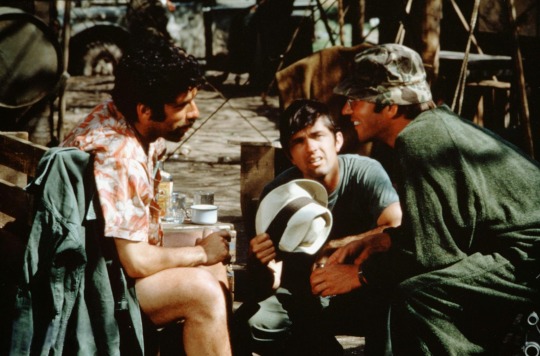

The next film on the AFI List is what is often called a dark comedy, M*A*S*H (1970). This was a highly rated movie by critics although it was overshadowed by Patton that came out the same year. The film earned nominations for Best Picture, Best Director, Best Supporting Actress, and Best Editing while winning for Best Screenplay. This is the first major feature length film for director Robert Altman after years spent directing for television. This experience is very apparent because the film experience is like binge watching webisodes online. Many short stories that come together around a group of characters in a specific setting. I want to go over the story before any further critique and I will break it down like episodes of a TV show. Oh yeah...
SPOILER ALERT!!! THERE IS A LOT TO THIS FILM SO REVIELING THE PLOT WON’T REALLY SPOIL THE EXPERIENCE, BUT I WANT TO BE SURE TO WARN ANYBODY BEFORE I START SPOILING DETAILS!!!
------------------------------------------------------------------
The film starts with the well known helicopters flying in with wounded soldiers with the theme of “Suicide is Painless.” These same shots were either used or simulated for the beginning of the television show. The tone is set to be a rather somber war film that deals with injuries and death in battle...until one of the groups moving the stretchers falls over and the tone becomes uncertain.
We then meet two new surgeons that are assigned to the 4077 unit. They are Captain Hawkeye Pierce (Donald Sutherland) and Captain Duke Forrest (Tom Skerritt). They are insubordinate smart aleks who take a jeep without a driver and go off to the medical outpost where they are assigned. They immediately run into Major Burns (Robert Duvall) with whom they share an officer’s tent. Duke and Hawkeye have a rule breaking style that does not mesh with the extremely strict and religious Major. The two immediately ask for the Major to be moved. They get a new tent mate in Captain Trapper McIntyre and we have our three doctors. Also in the camp are Colonel Blake (Roger Bowen), Major “Hot Lips” Houlihan (Sally Kellerman), the dentist “Painless” (John Schuck), and Lieutenant “Dish” (Joann Pflug).
The first situation is dealing with Burns. He is indoctrinating a local teen by having him read the bible. Not really too bad. The man is annoying and I couldn’t remember why he got such a bad rap. However, he blames an assistant (who is not a nurse and played by Bud Cort) for the death of a soldier when the man was going to die anyway, and Trapper takes exception and punches Burns in the face. Burns then starts to court the new Major and the three docs broadcast them being intimate over the loudspeaker. She tells Burns to kiss her hot lips and gains her nickname. Hawkeye rags on Burns about the incident until the Major attacks the Captain and Burns is taken away for psychiatric discharge. The three doctors respect Houlihan’s nursing skills, but they still really hate her neurotic adherence to the rules.
The next situation involves the dentist, Painless, who was unable to perform sexually with a visiting nurse so he believes he is gay and wants to kill himself. The doctors form a scheme to give the dentist a pill that will knock him out and also give him an erection (like a Cialis sleeping pill). Painless believes the pill will kill him and everyone says their goodbyes. All the surgeons have dinner together in a scene reminiscent of the last supper and then Painless is given his pill and lays down in a coffin while a reprise of “Suicide is Painless” plays in the background. Once Painless is out, a good looking nurse who is about to leave for home, Lieutenant Dish, is convinced to have sex with the dentist to convince him he is not gay. It works and the Lieutenant leaves in the morning and the dentist changes his mind about dying.
There is a brief interlude where the docs wonder if Hot Lips is a natural blond. To find out, they set up a scheme in which they drop open the side of a shower tent while the Major is there so they can see her pubic hair and compare. It is a rather mean prank that the whole camp is in on, and Houlihan goes to Colonel Blake and complains that he lets the surgeons get away with everything. He tells her to get out because he is sleeping with a nurse and drinking alcohol that was brought in by the three doctors.
The third situation involves Trapper and Hawkeye going off to Japan to perform emergency surgery on the son of somebody with influence. While there, they also use the facility to help a baby of one of the local prostitutes. They are caught with the possibility of legal repercussions, but blackmail the local officer with pictures of him with the prostitute. They get their way and are able to go back to the 4077. When they get back, it turns out that Duke has been sleeping with Hot Lips because he likes blondes.
The final situation is a little out of the blue but perhaps the most well known aspect of the film. The 4077 is challenged to a football game by local evacuation unit 325. The two camps both get ringers to play as there is a $5000 wager on the game. The 4077 holds back their ringer for the first half and sabotage the best players of the 325th so they can increase the wager and the odds at halftime. It works and the 4077 bring in their ringer and are able to win on the last play.
The end is very much like the beginning in that Hawkeye and Duke are given their papers to go home and they steal the same Jeep to leave together. There are no closing credits but the actors are all mentioned on an overhead announcement that breaks the 4th wall of the film. Very creative and a pretty satisfying ending.
-----------------------------------------------------------------------------
Like I said at the beginning, this doesn’t really feel like a film but more of a series of episodes. It is no wonder that it translated so well to television and became one of the most popular shows of all time. There was only one actor that went from the movie to the TV show and that was Colonel Blake’s secretary known as Radar, who was played by Gary Burghoff. This is one of the few films on the AFI list that you can watch in parts or step away from and not really miss anything. It was a lot different from anything that had been done before, but it does seem a little incohesive.
My mom is not a fan of this film specifically because of the way that these three doctors treat everyone else. Major Burns does not really deserve his fate and the nurses are constantly used for their sex appeal. The three are incredibly mesogenistic, Duke is kind of racist when there is a discussion of a black man staying in their tent, and Painless would rather die than possibly live his life as a gay man. All of these characters are in a horrible situation, but the audience is supposed to automatically favor the flippant care-free doctors. Burns and Houlihan are not really played out as terrible people but we are supposed to laugh as these surgeons torture them. The joke really doesn’t hold up.
I really think that this movie is a great time capsule for the time period. Men were being drafted to go off to war and it was believed that they were being stripped of their humanity and turned into killers. Vietnam was a war that many Americans didn’t want to be a part of so the idea that the war experience could be good with the right attitude appealed to many. The graphic nature of the surgery scenes made the situation feel real so the movie going audience cheered for those men who could do their job while keeping their sanity and their frat boy sense of humor intact. Again, that is not the humor of the nation currently so the gags don’t really hold up. It does give the viewer a glance into the mindset of the audience at the time.
After Nashville, I don’t have that much to say about the cinematography. Altman definitely has wide shots in which a lot is happening, but it is set at a small army camp in which it is hard to tell the actors in uniform apart. A lot of the action is lost. Also, there are far fewer characters in this film than in Nashville. Altman’s TV roots are much more evident in this film. That being said, the constant change really helps to move the movie along and I would say it is up with Raiders of the Lost Ark as far as quick pace.
So does this film deserve to be on the AFI list? I’m actually going to say no. The TV show that was inspired by this film made for some of the best episodic story telling on the small screen, but you can’t really give that to this film. The comedy really doesn’t hold up and the lack of any cohesive story lasting more than 15 minutes is very detrimental. Would I recommend it? Yes I would. It is fun and a pretty easy watch. I am really just not that sure how it got on the AFI list. It wasn’t highly awarded and many people don’t know there even was a movie before the TV show. It is an interesting bit of history, but it is no big deal if you skip this one. Watch the TV show instead.
11 notes
·
View notes